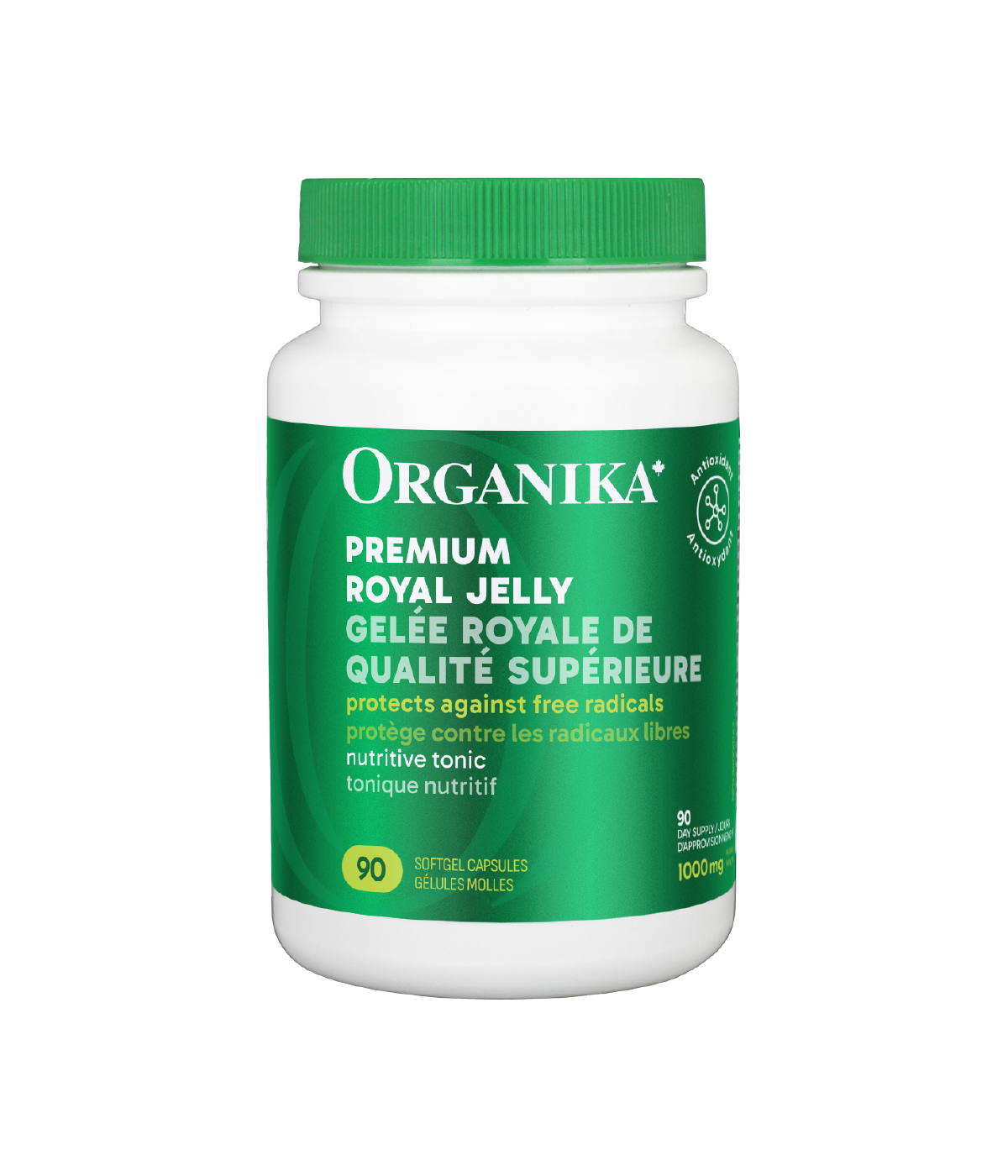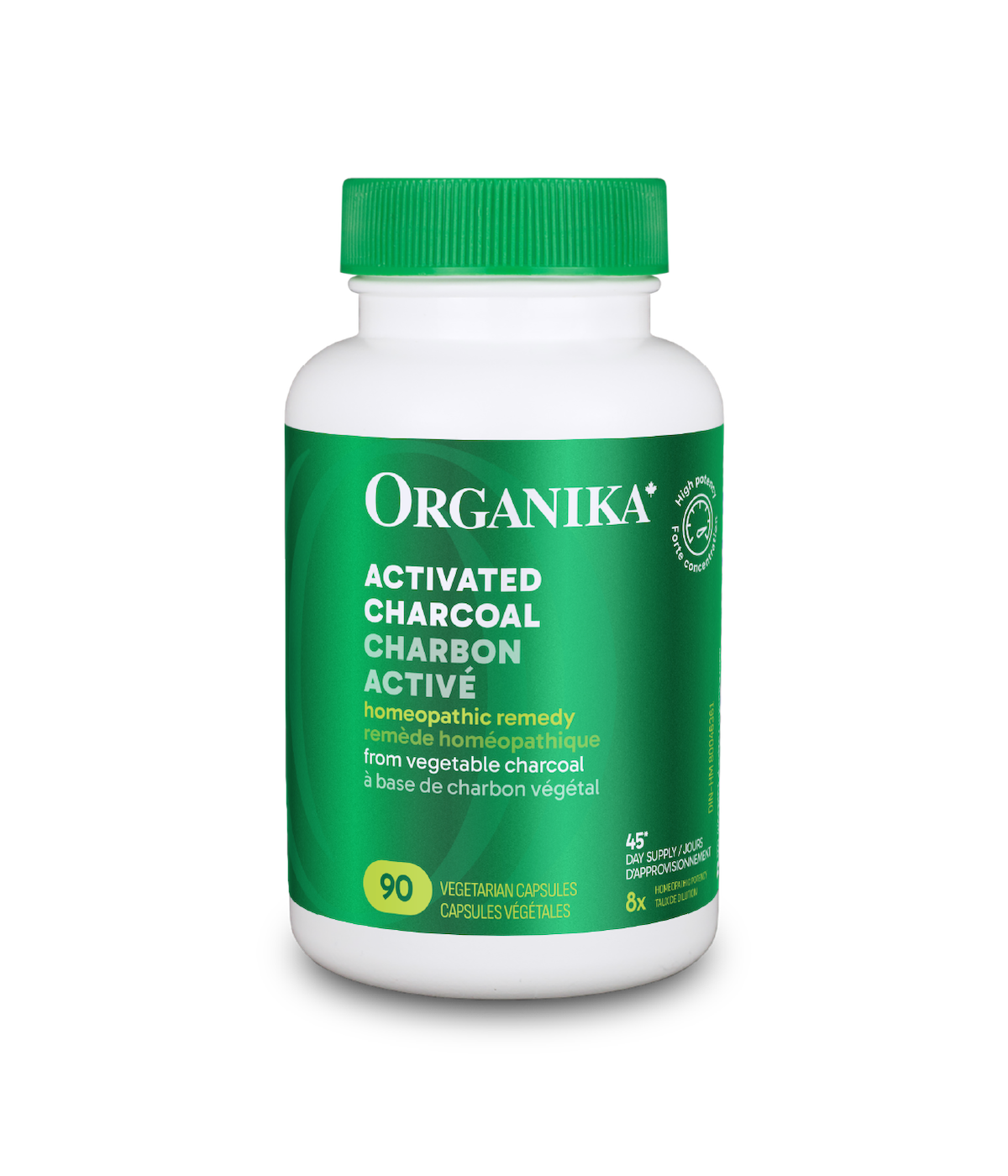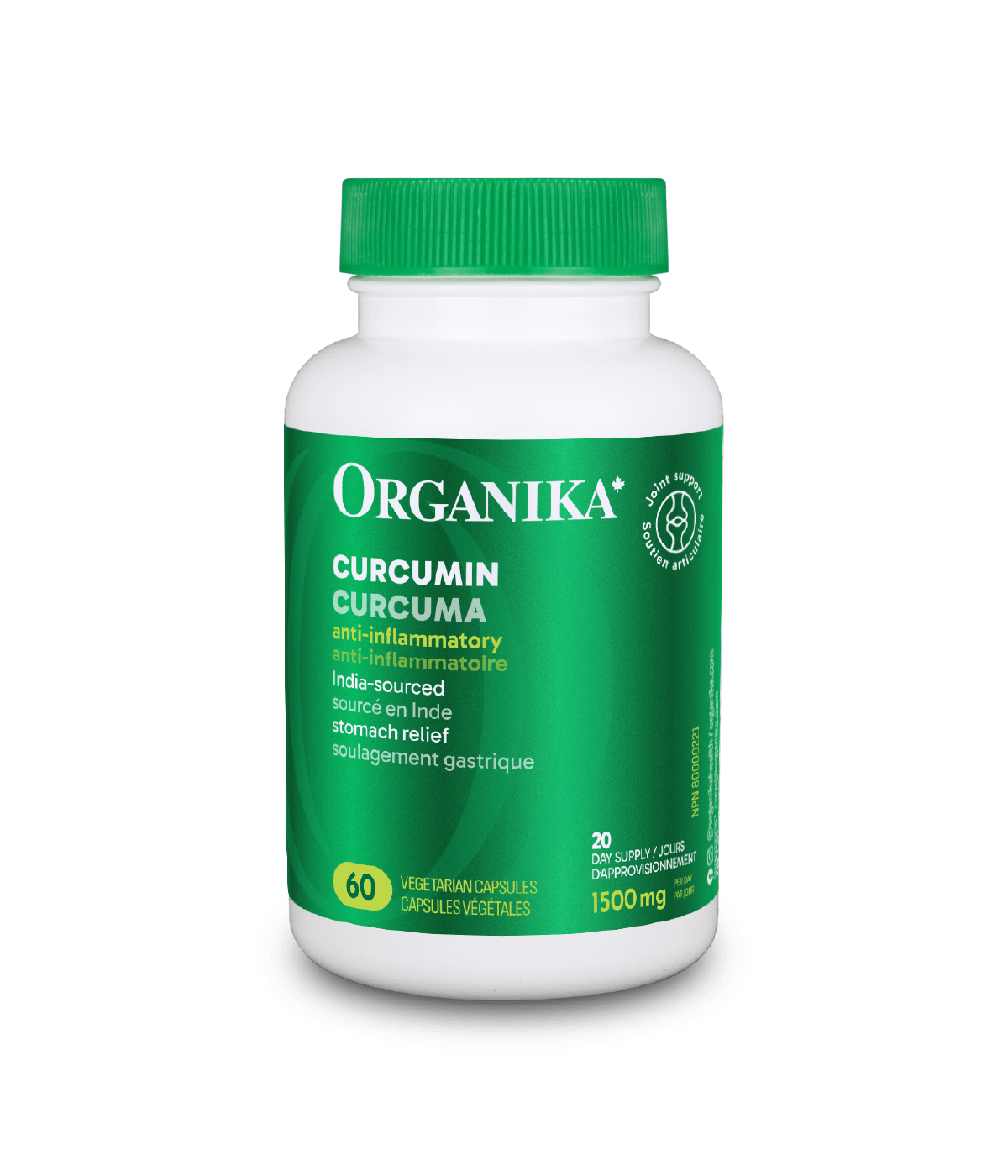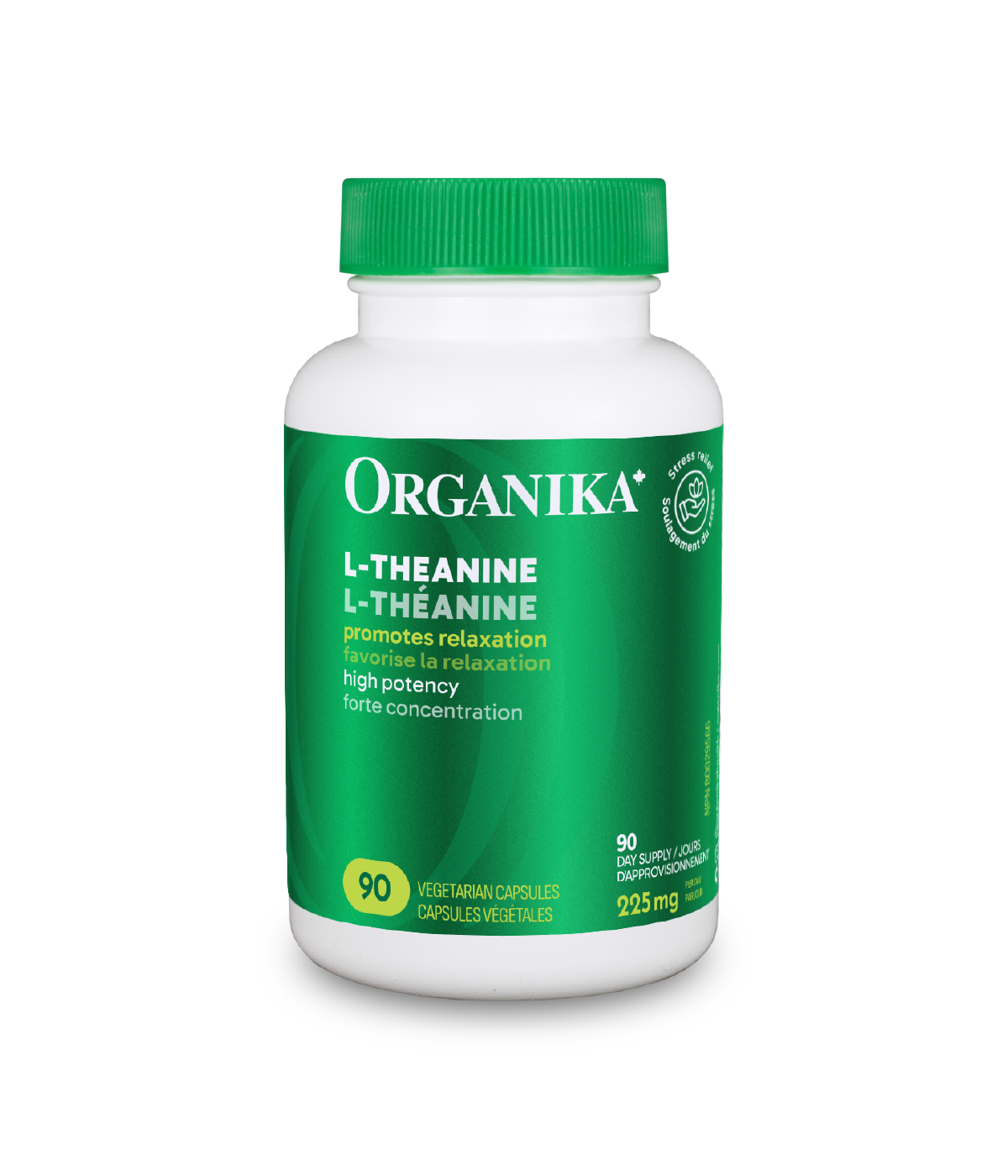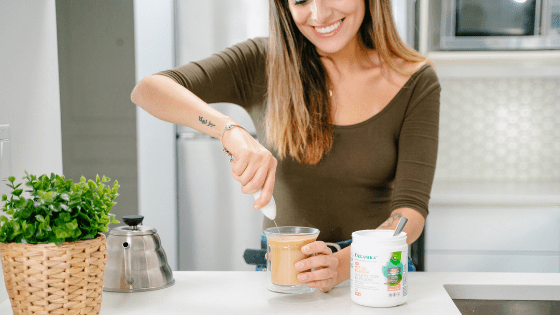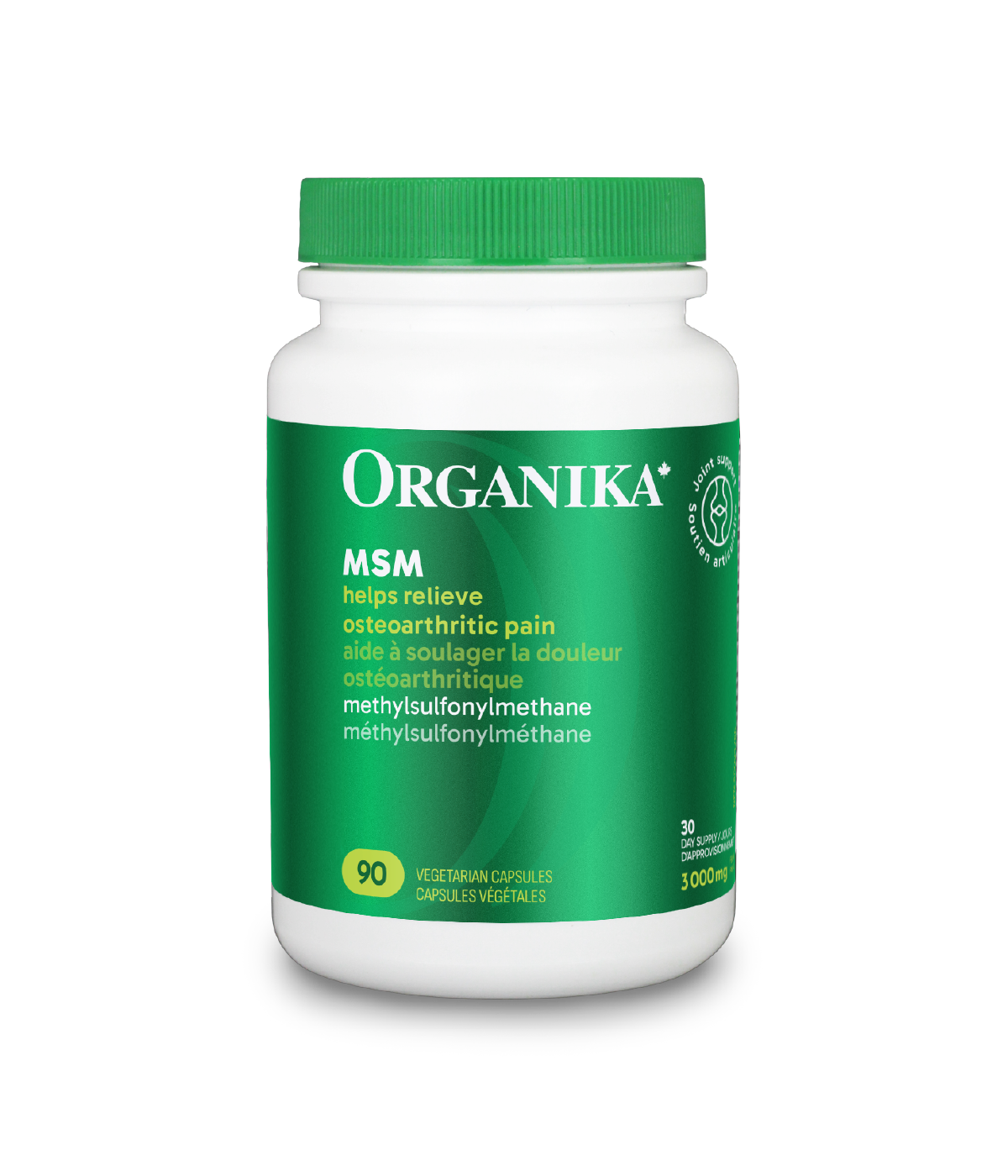
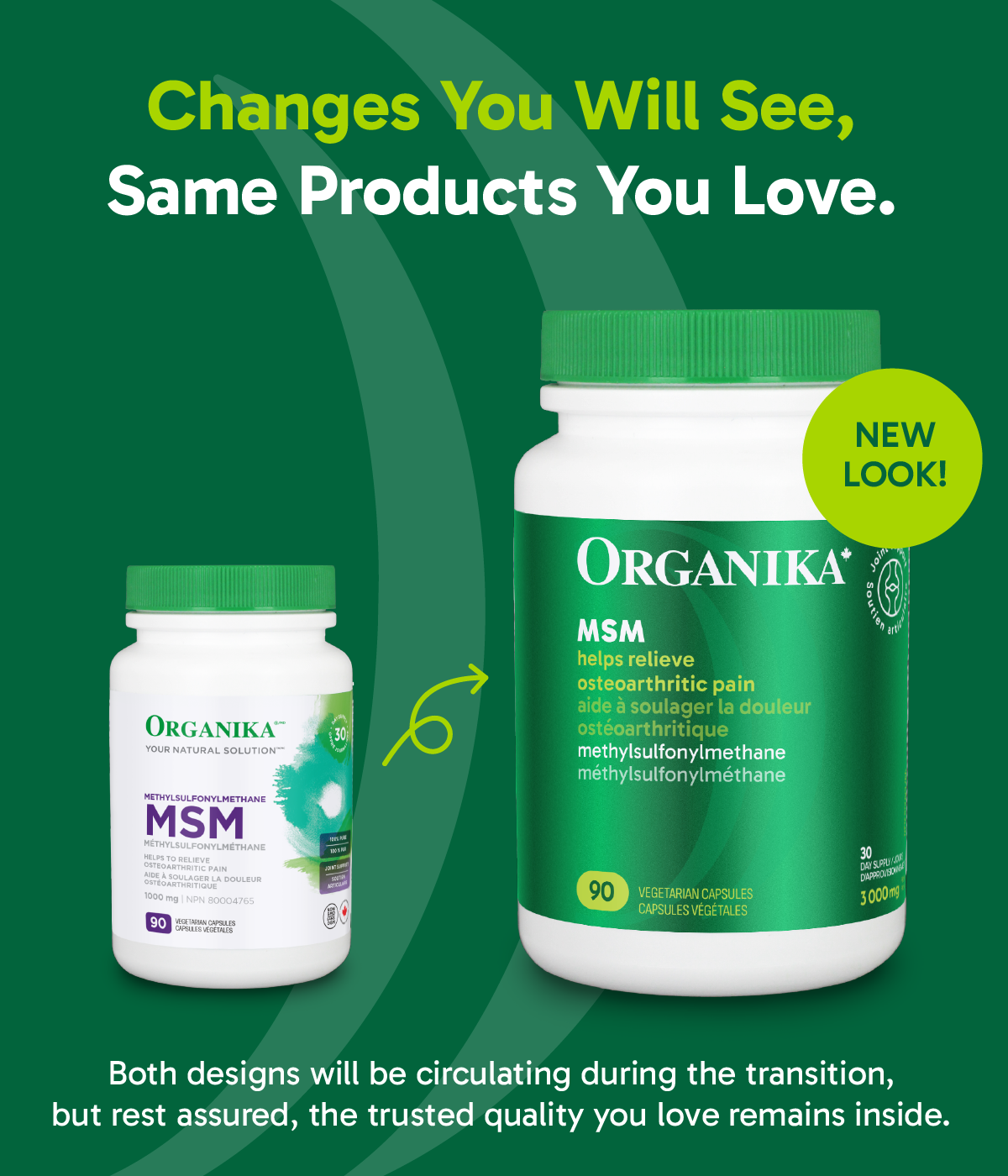
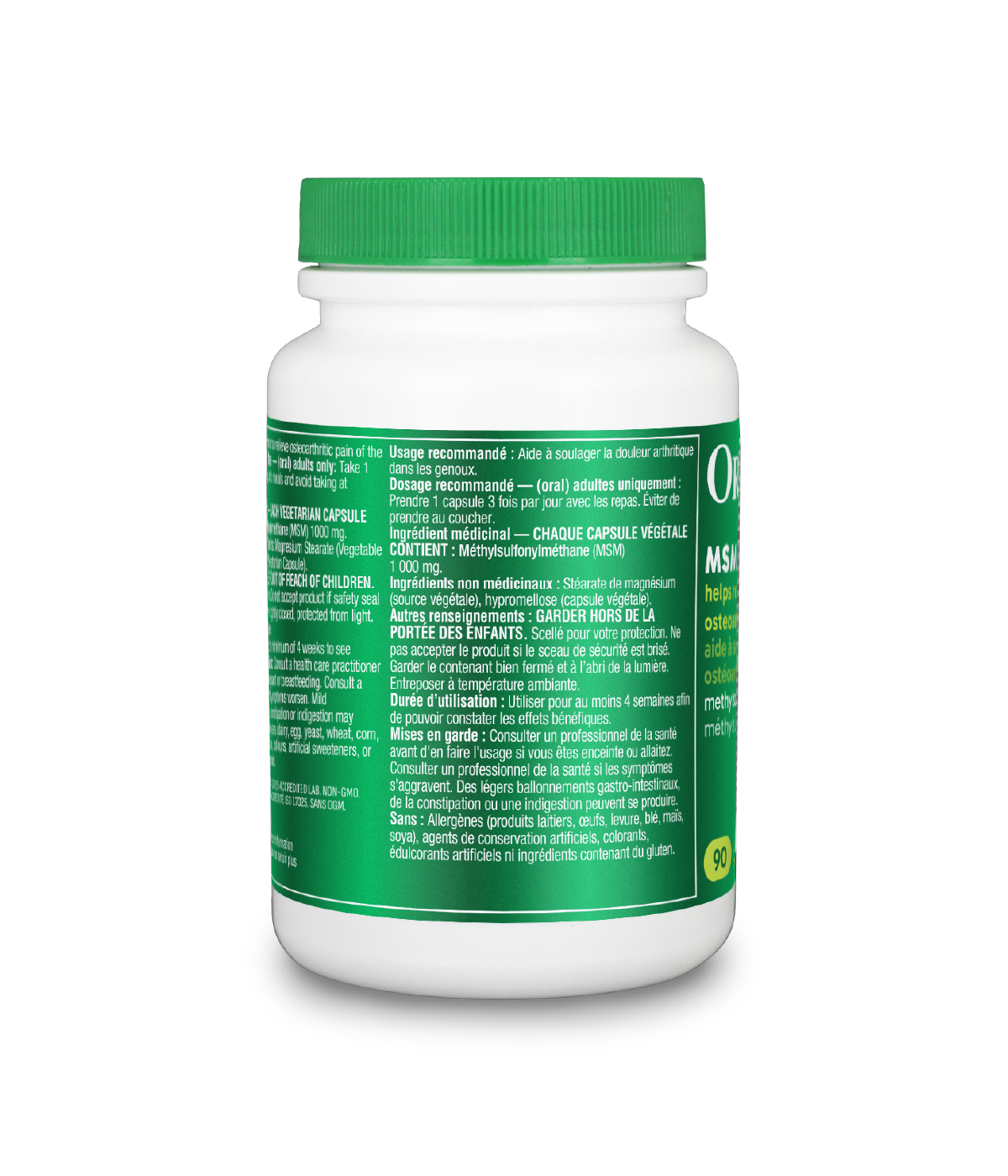
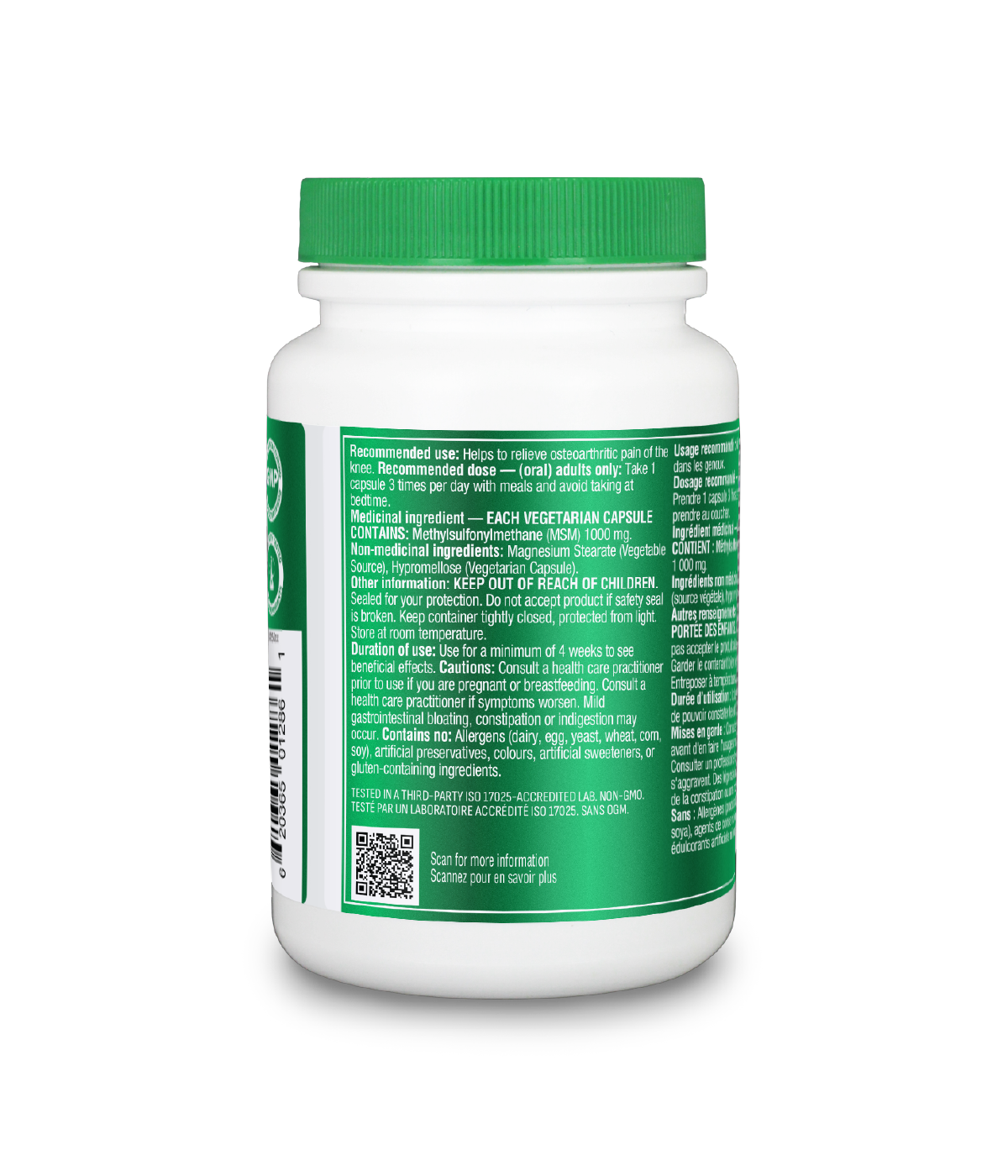
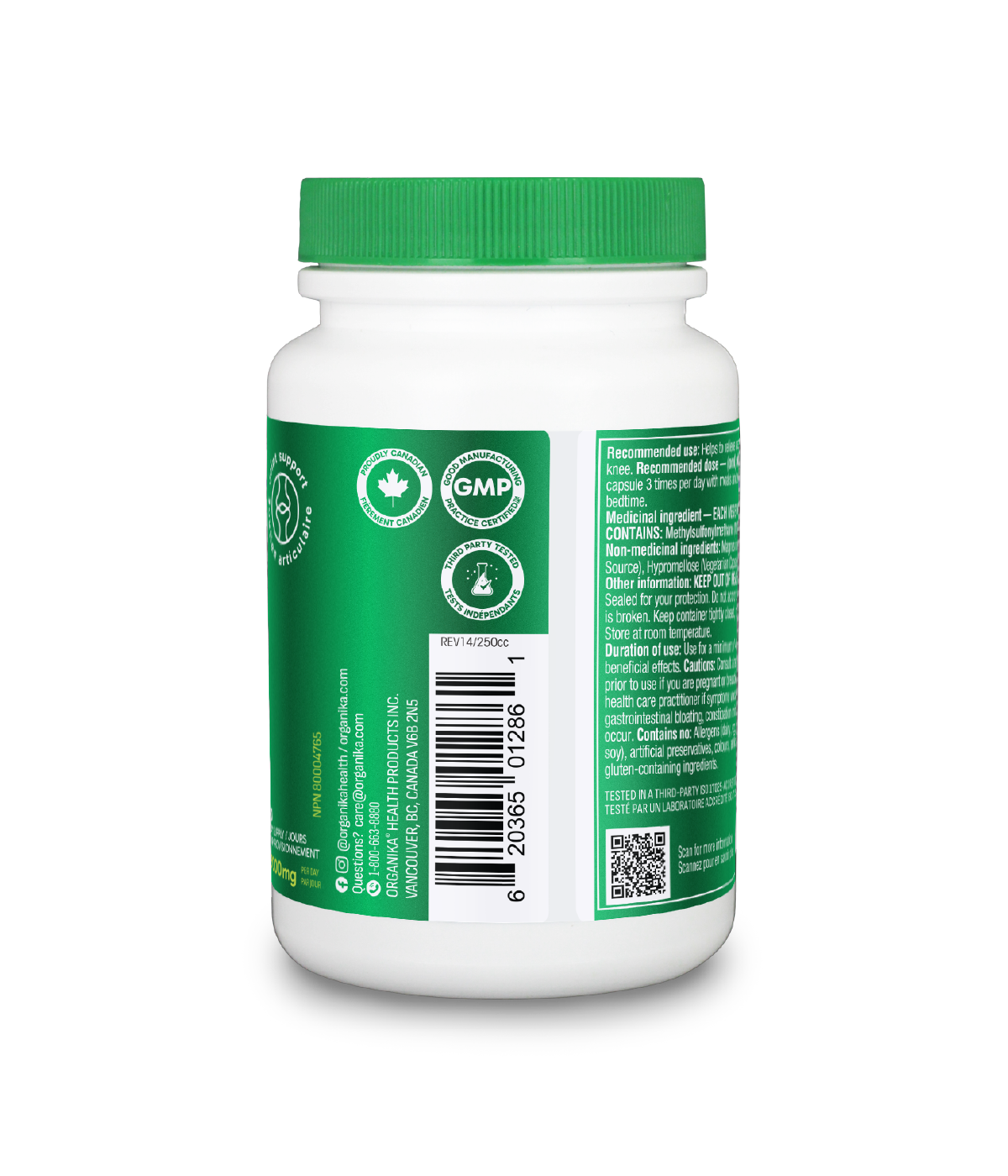
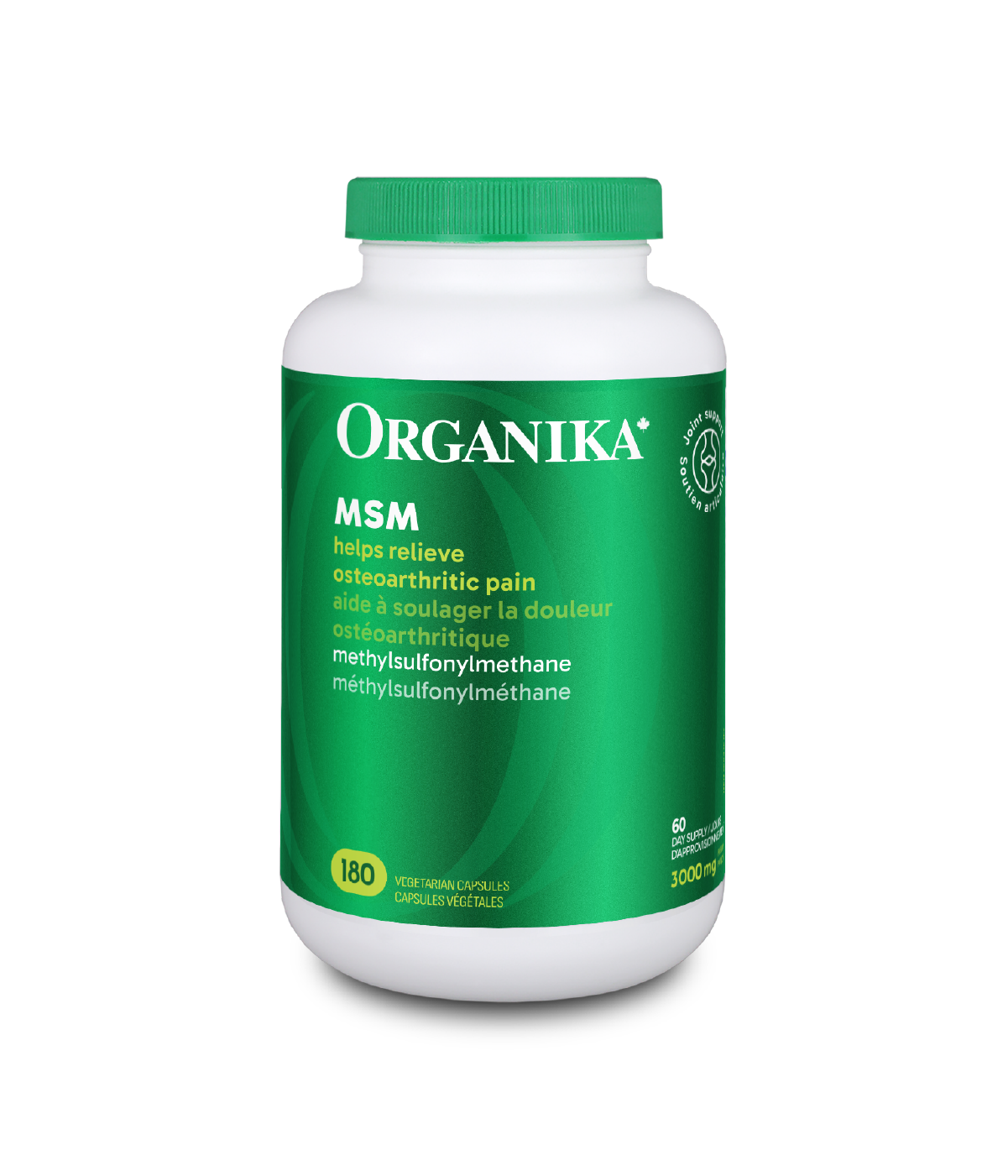
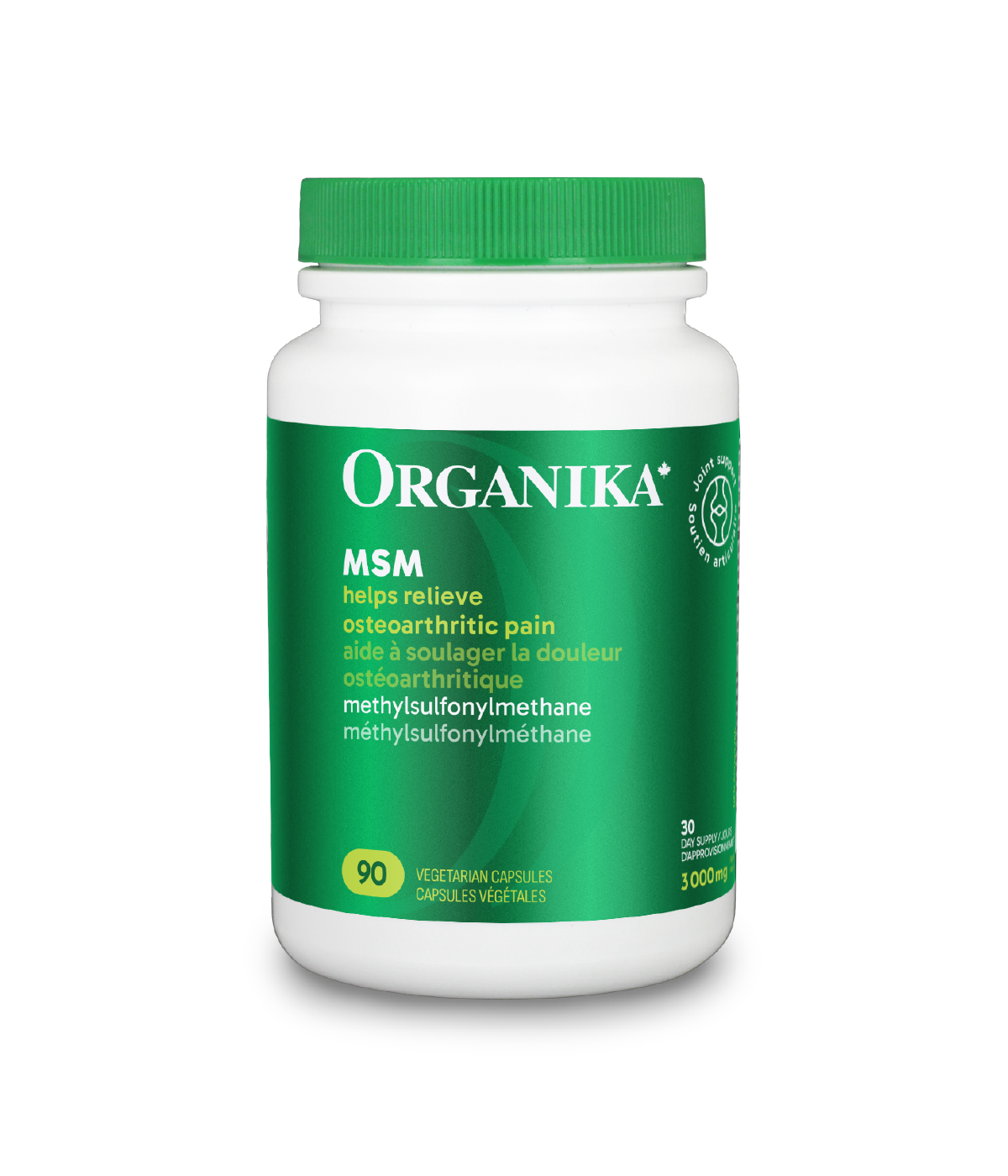
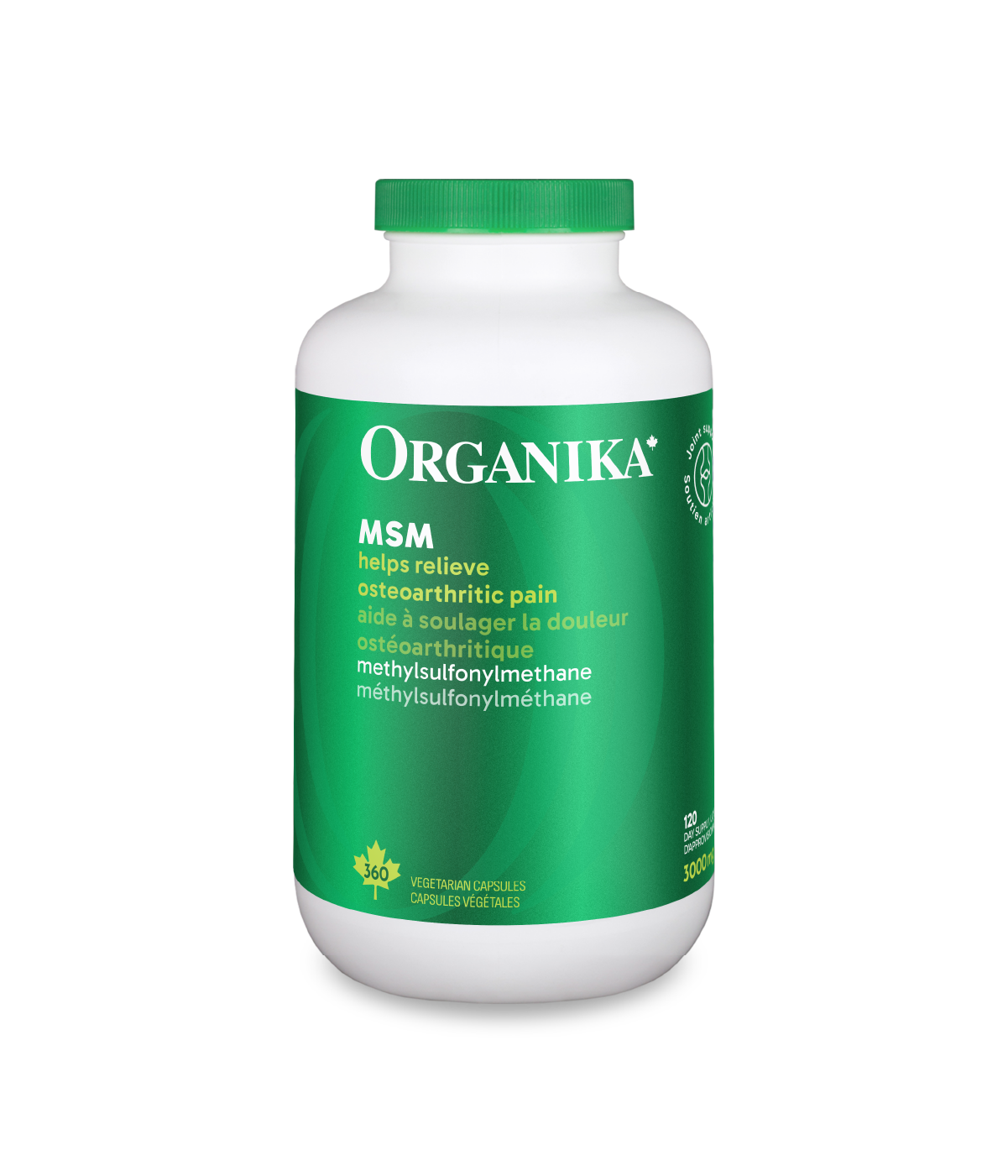

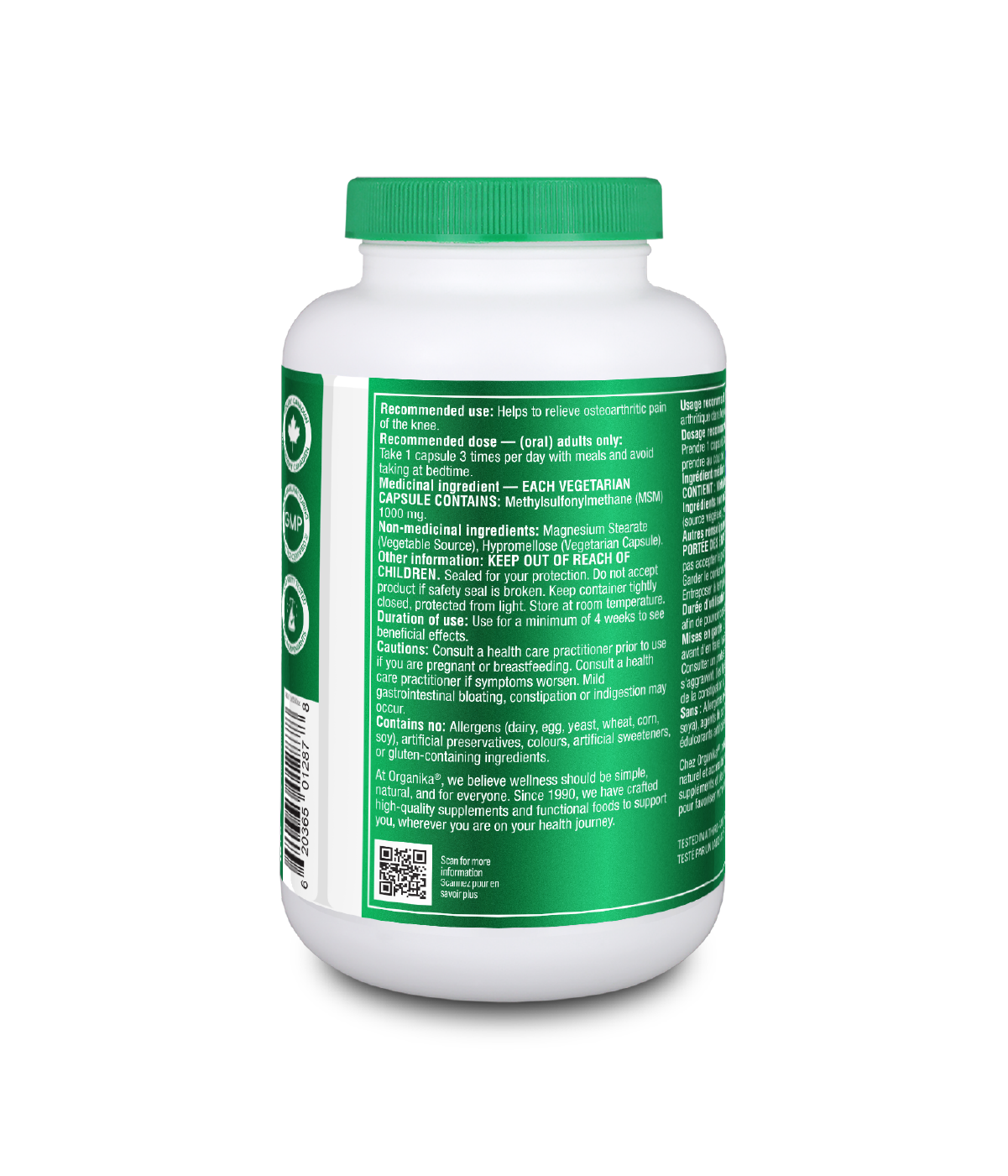
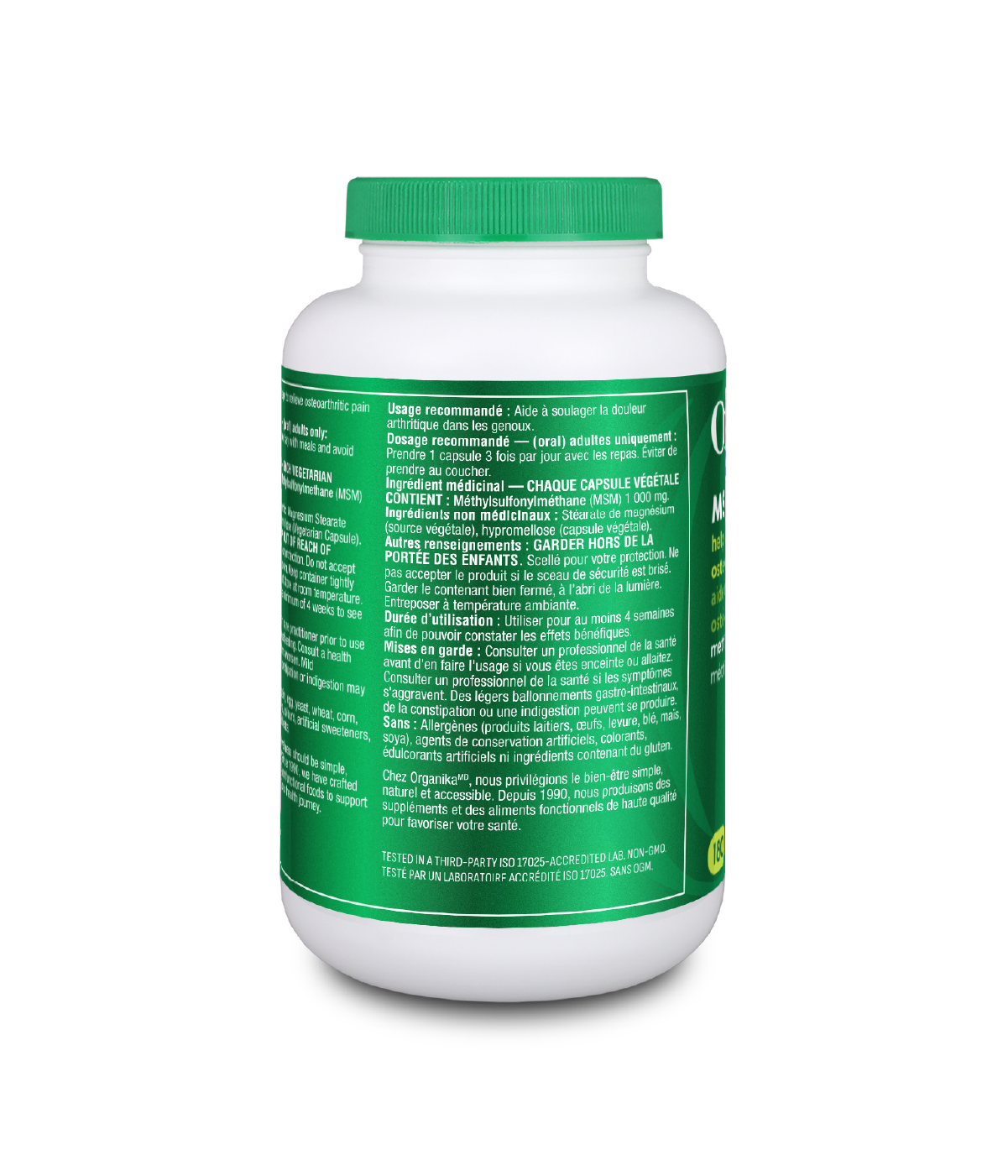
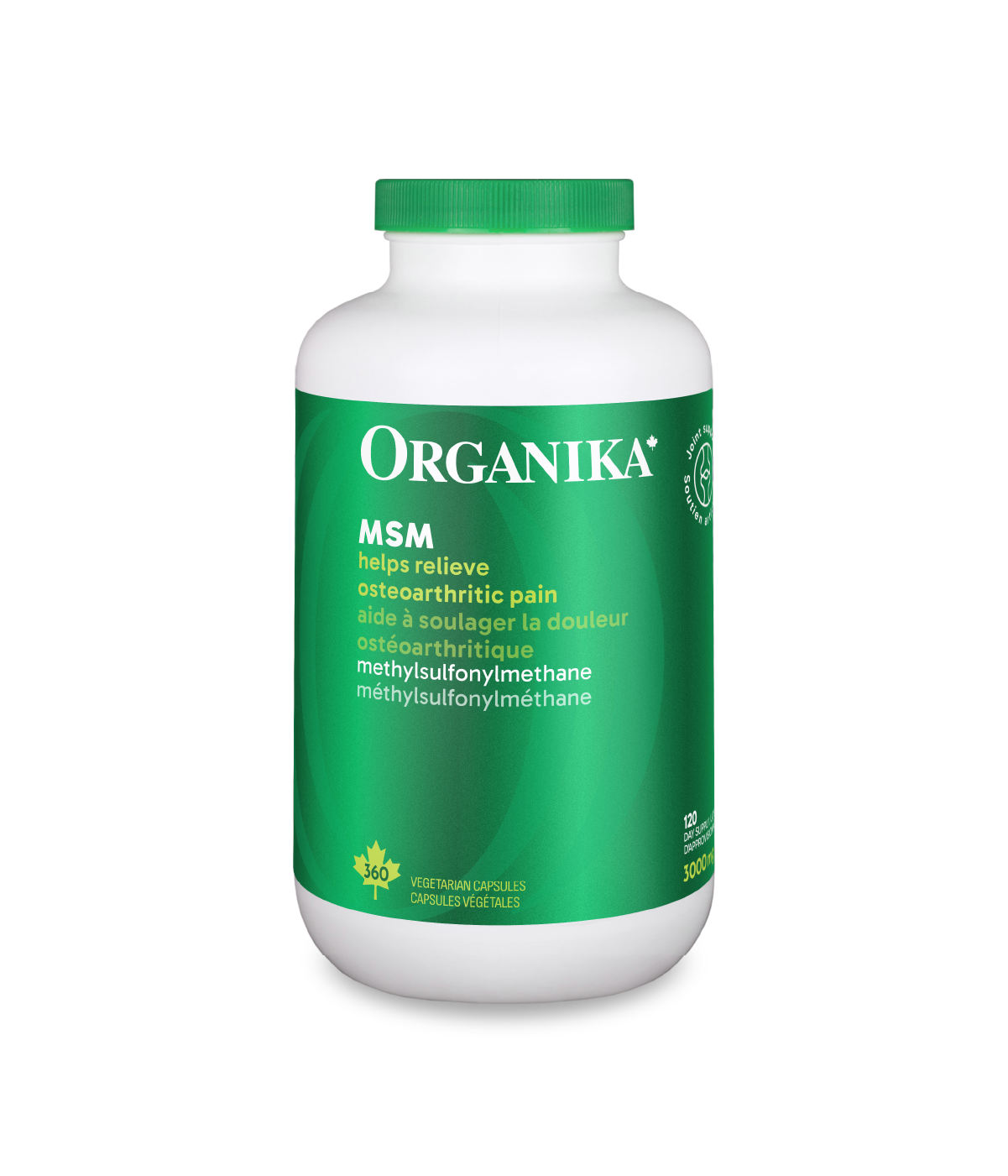
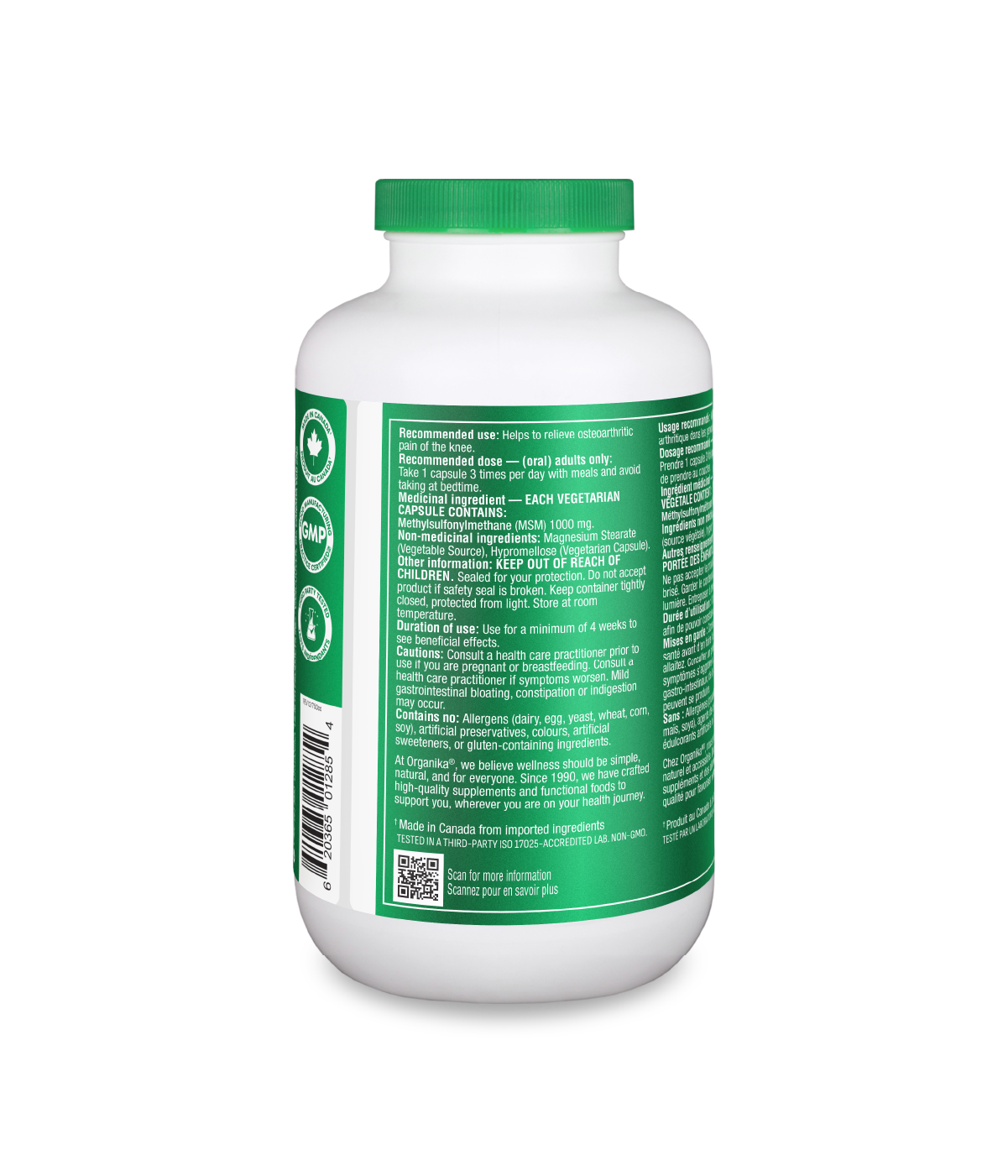
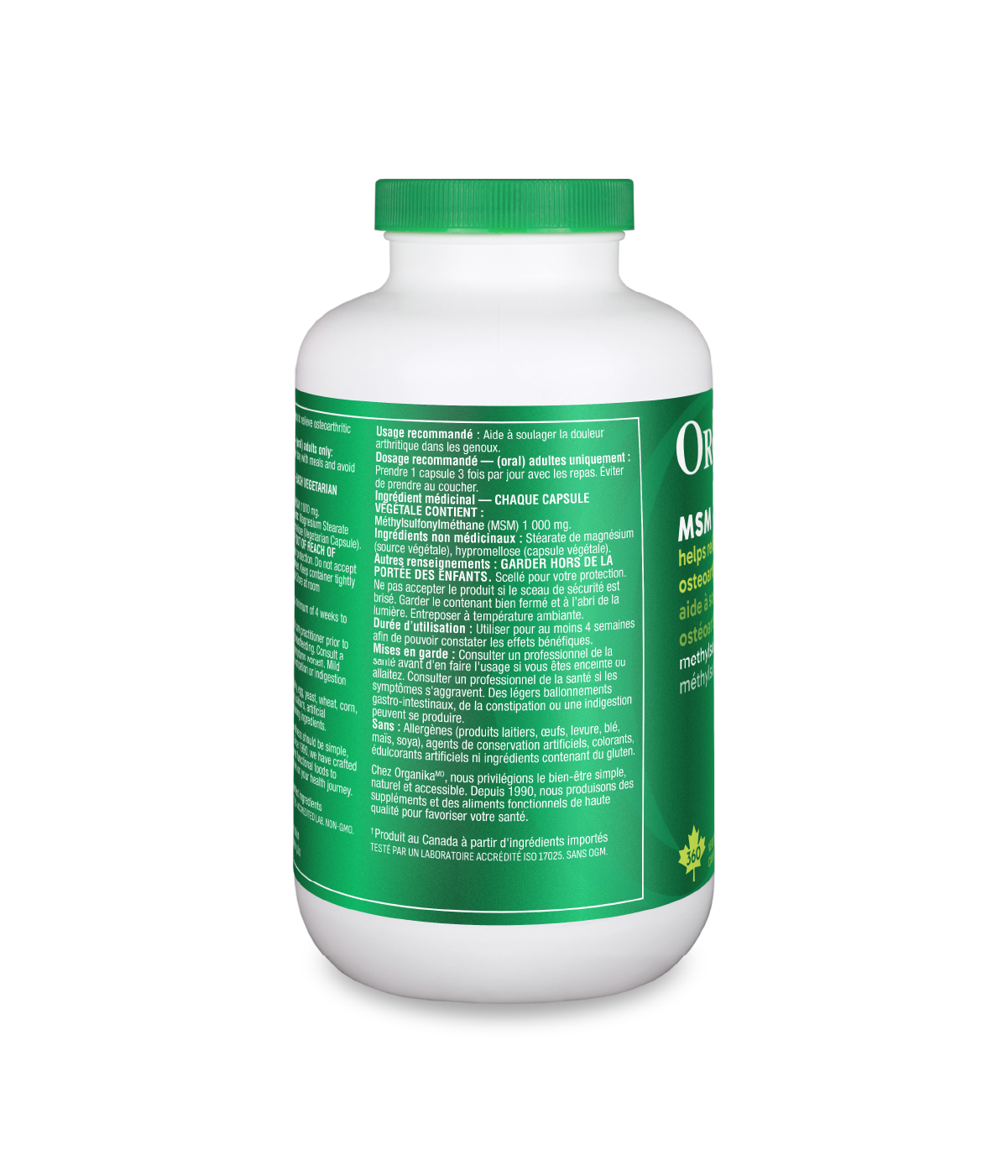
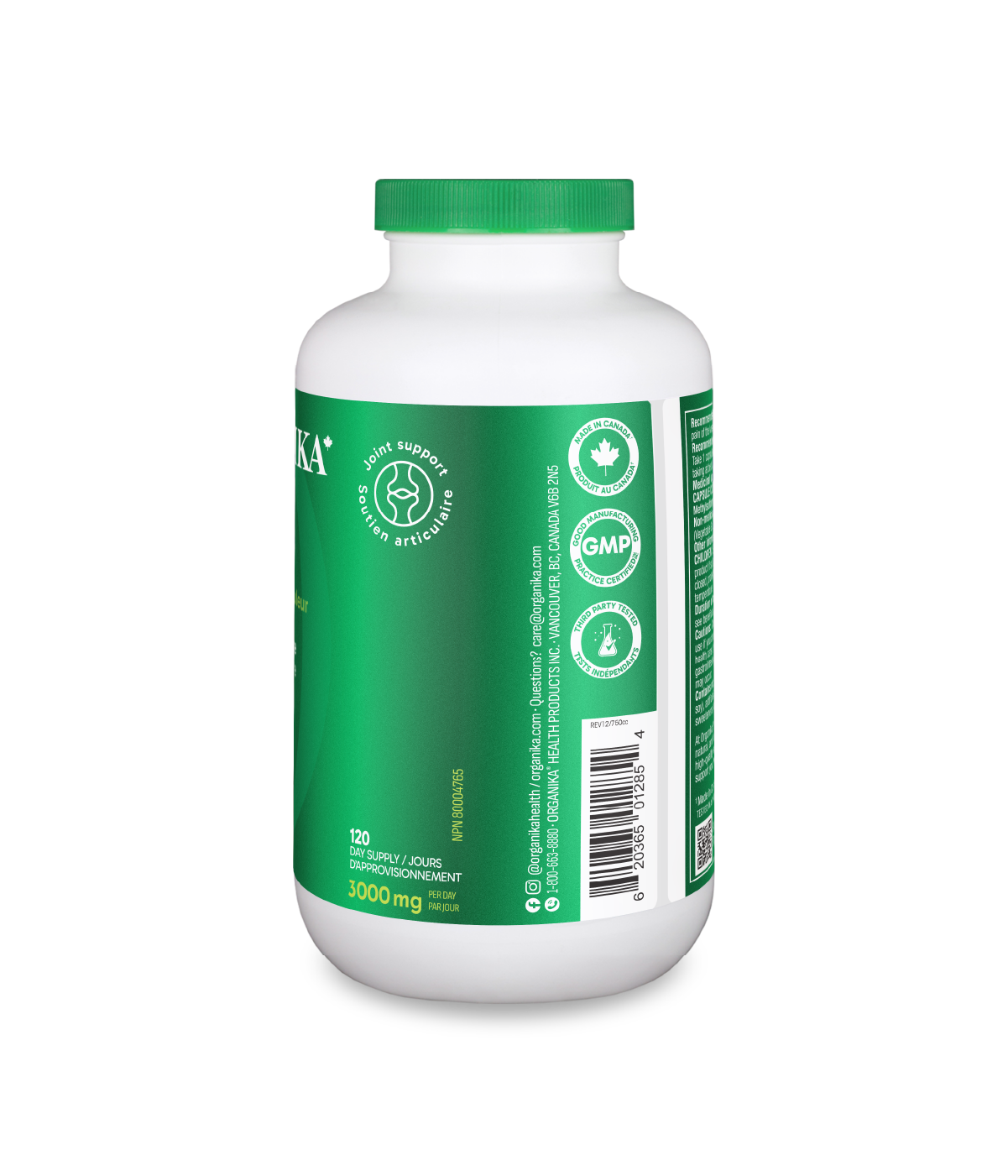




-
Is this right for you?

-


-


-

-

-

-

-

-

-

-

-

-

-

-

-

-

MSM
A sulphur-rich essential for joint comfort, muscle recovery and inflammation balance
- Reduces inflammation
- Relieves joint pain linked to osteoarthritis
- Restores flexibility and range of motion
- Reduces muscle pain and spasms
Impossible de charger la disponibilité du service de retrait



Notify Me When Available
Enter your email and we'll let you know as soon as this product is back
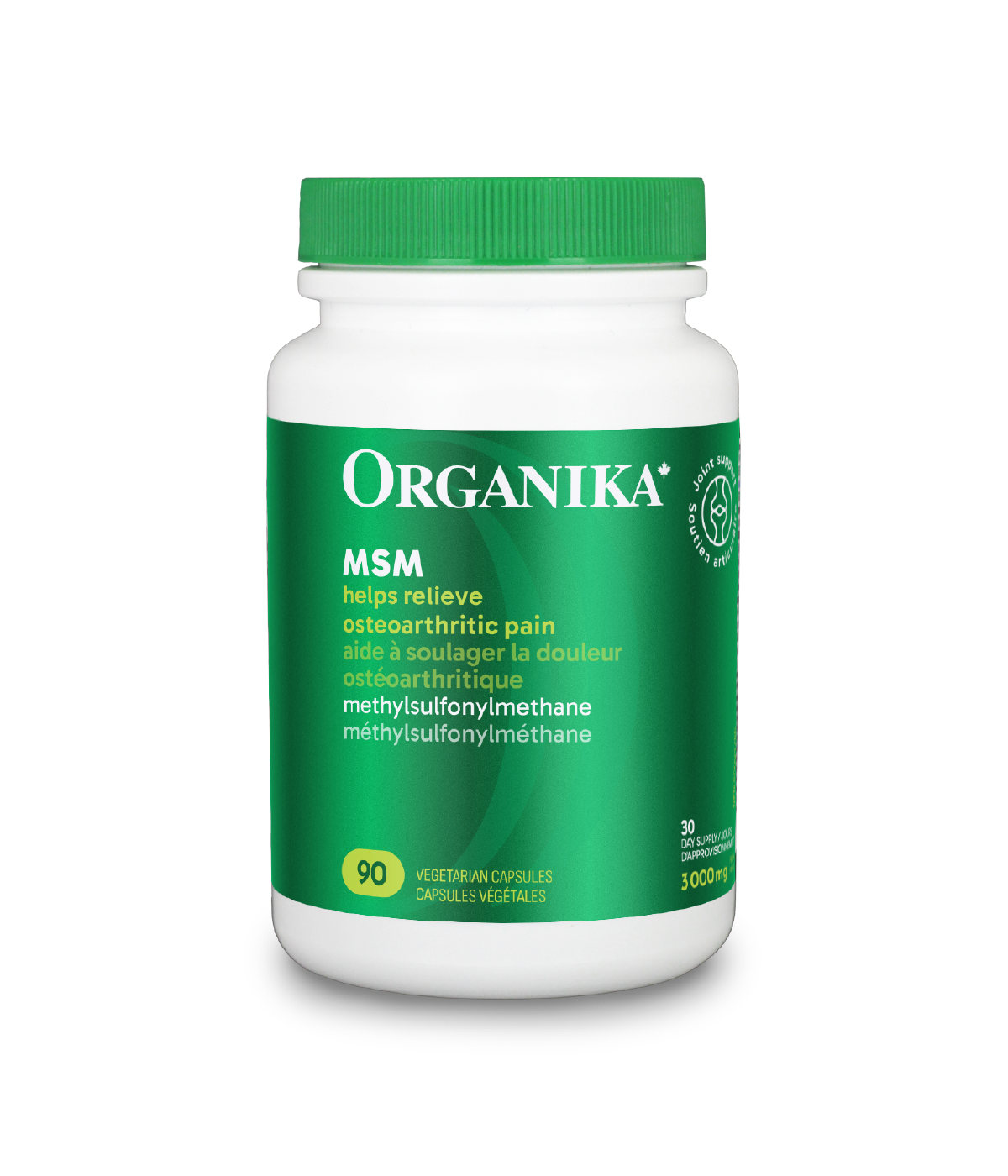
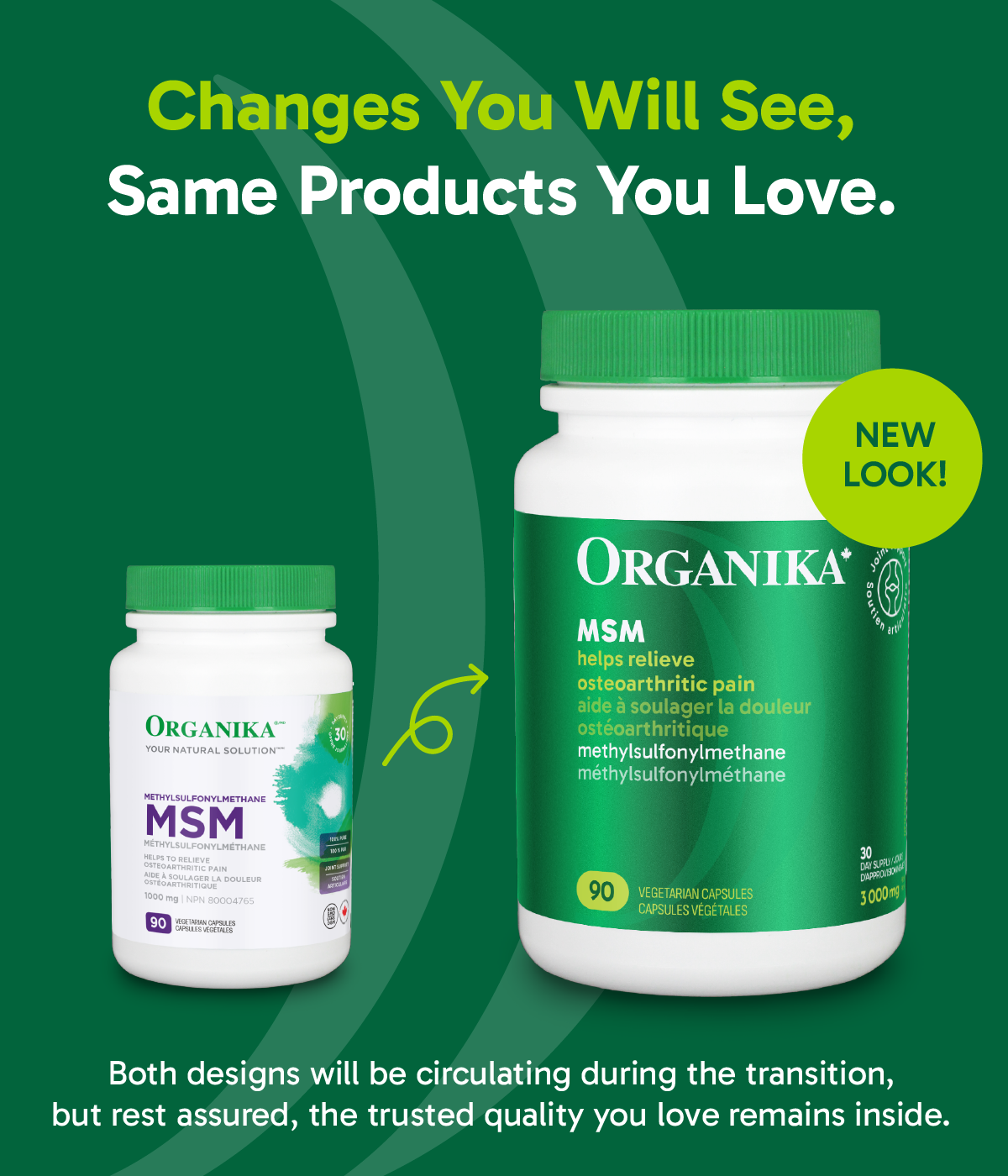
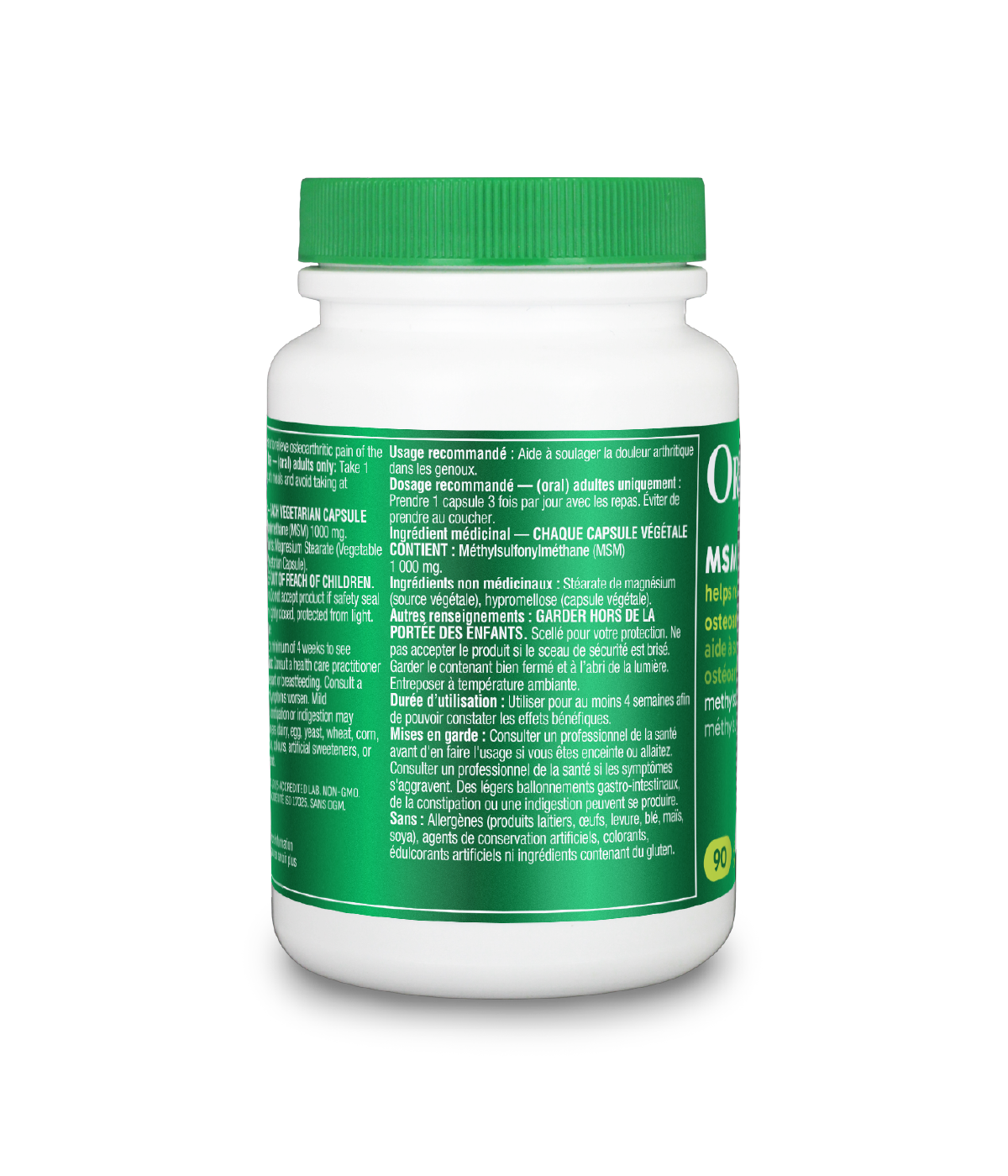
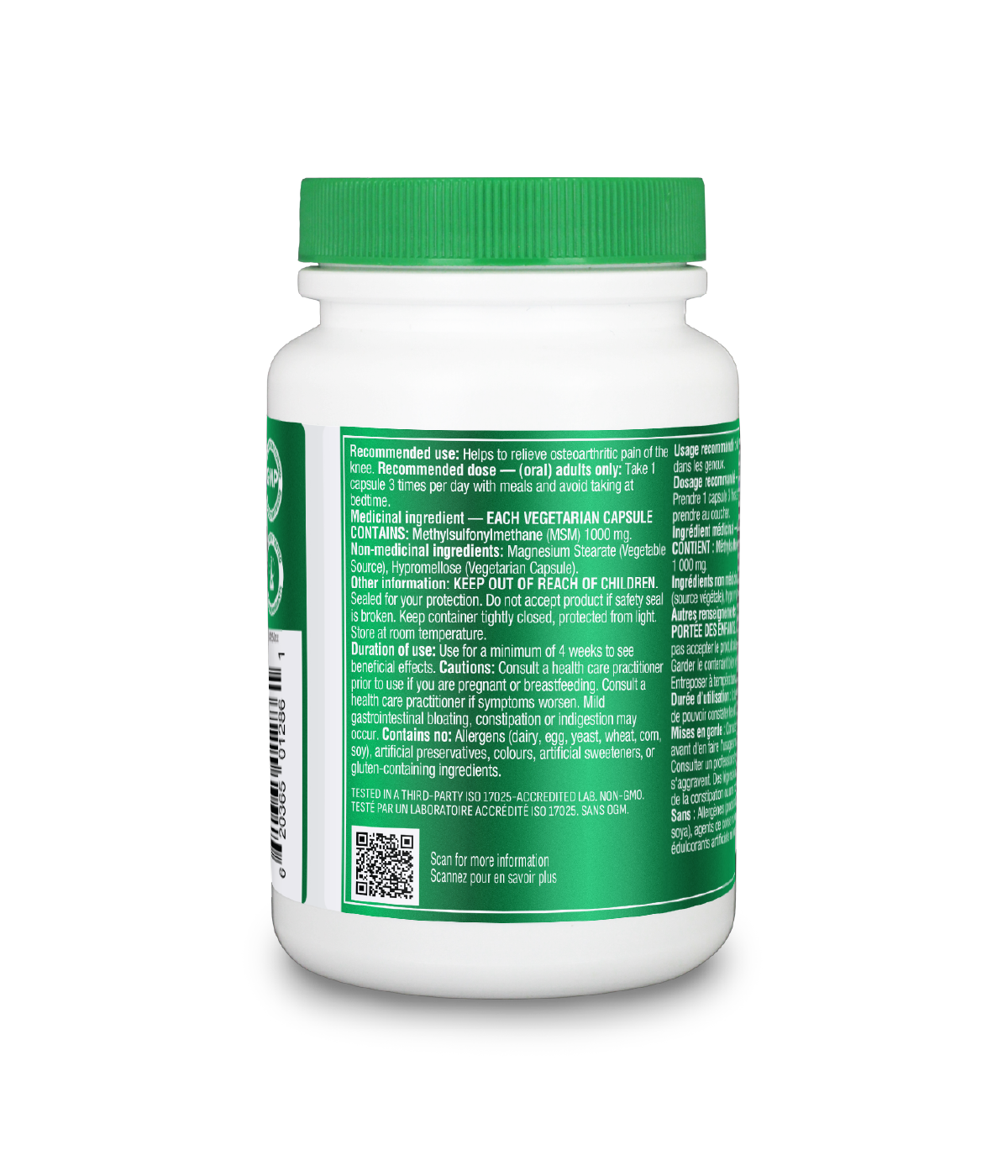
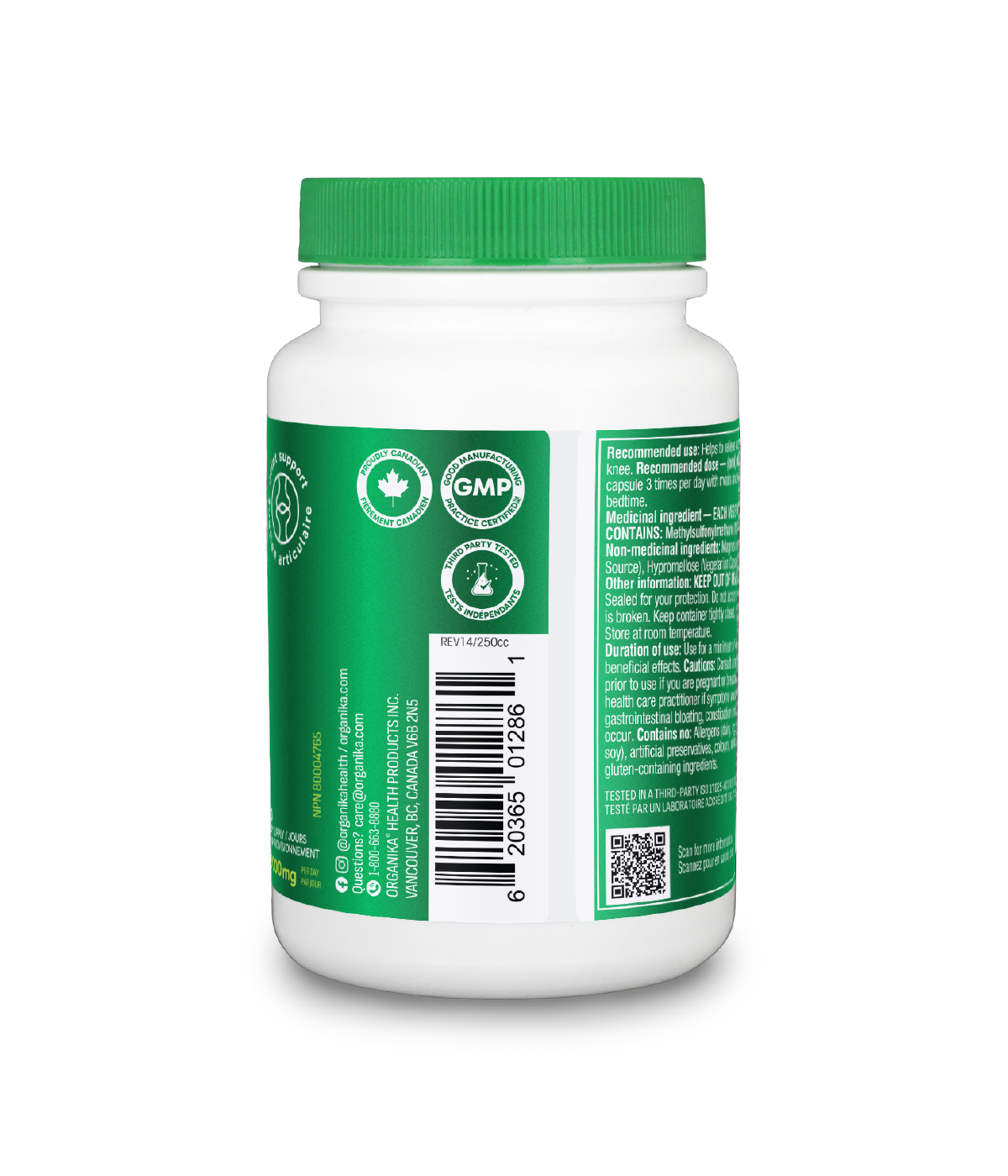
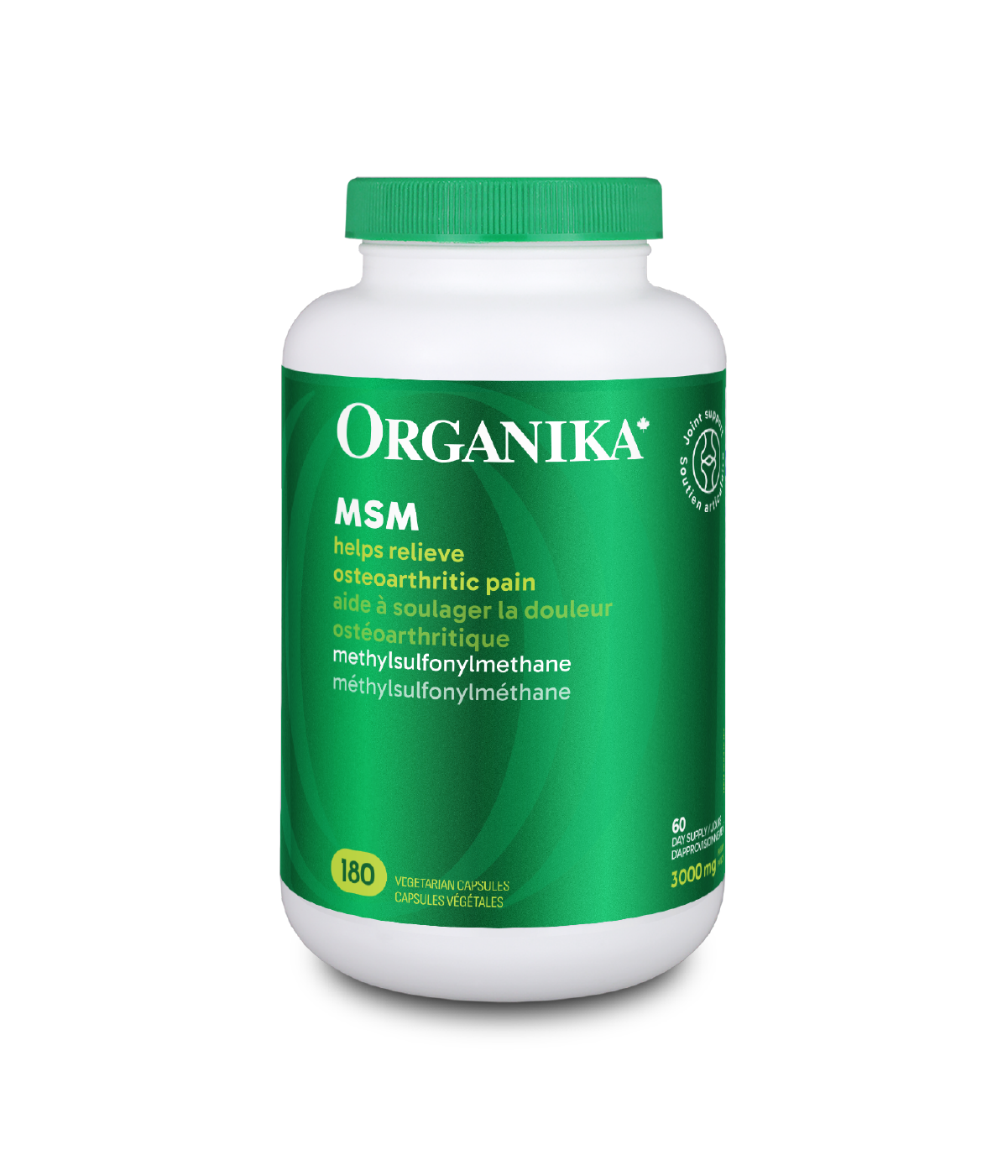

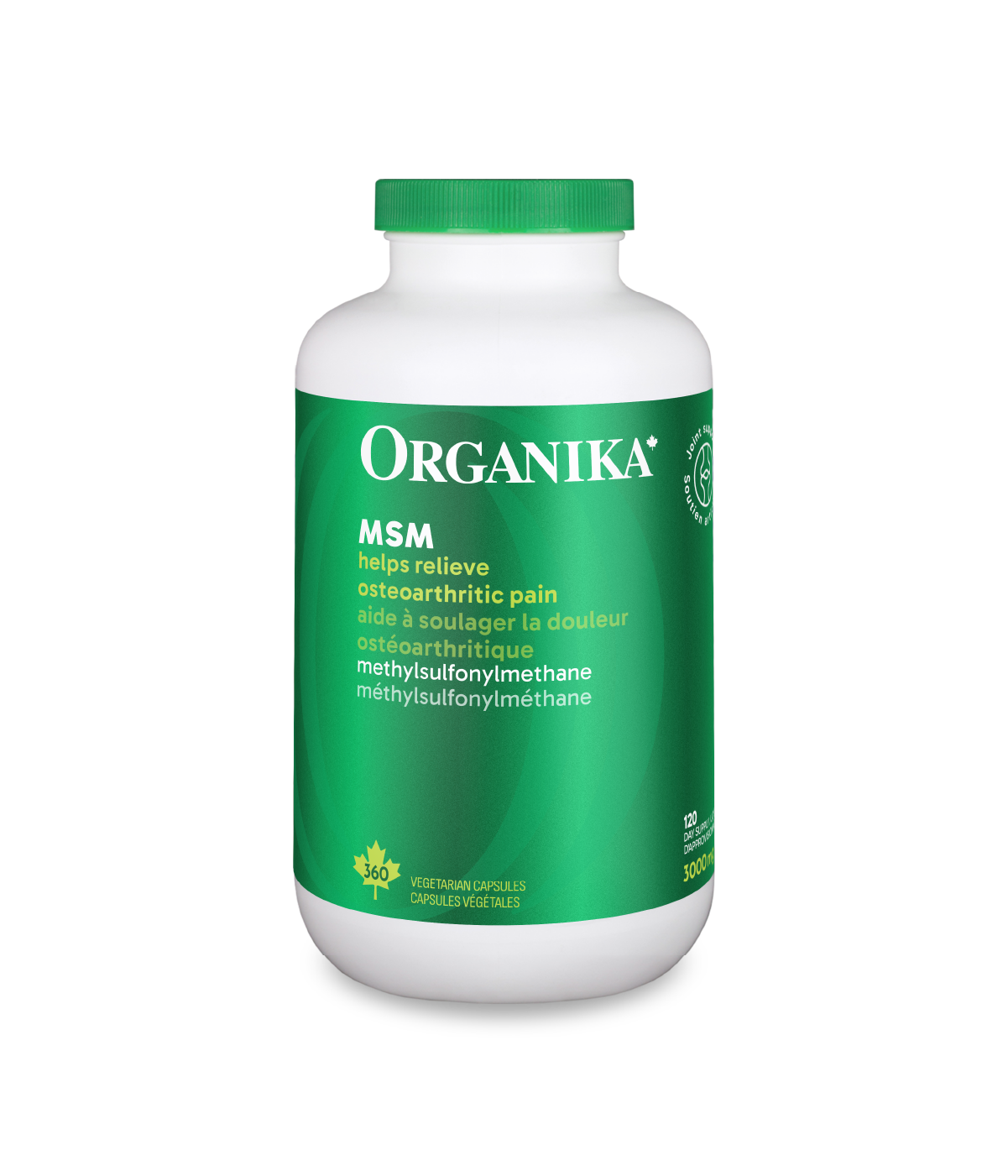
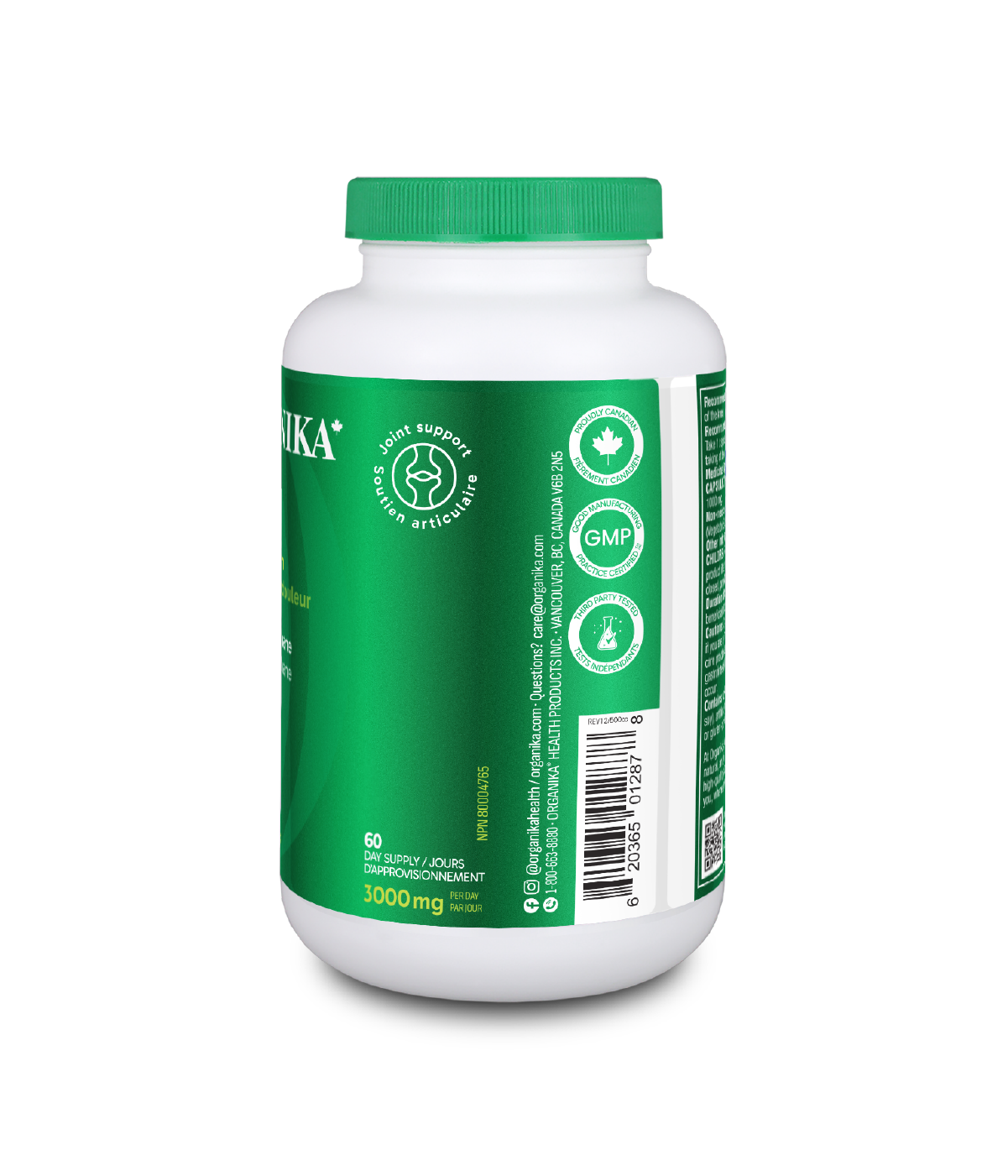
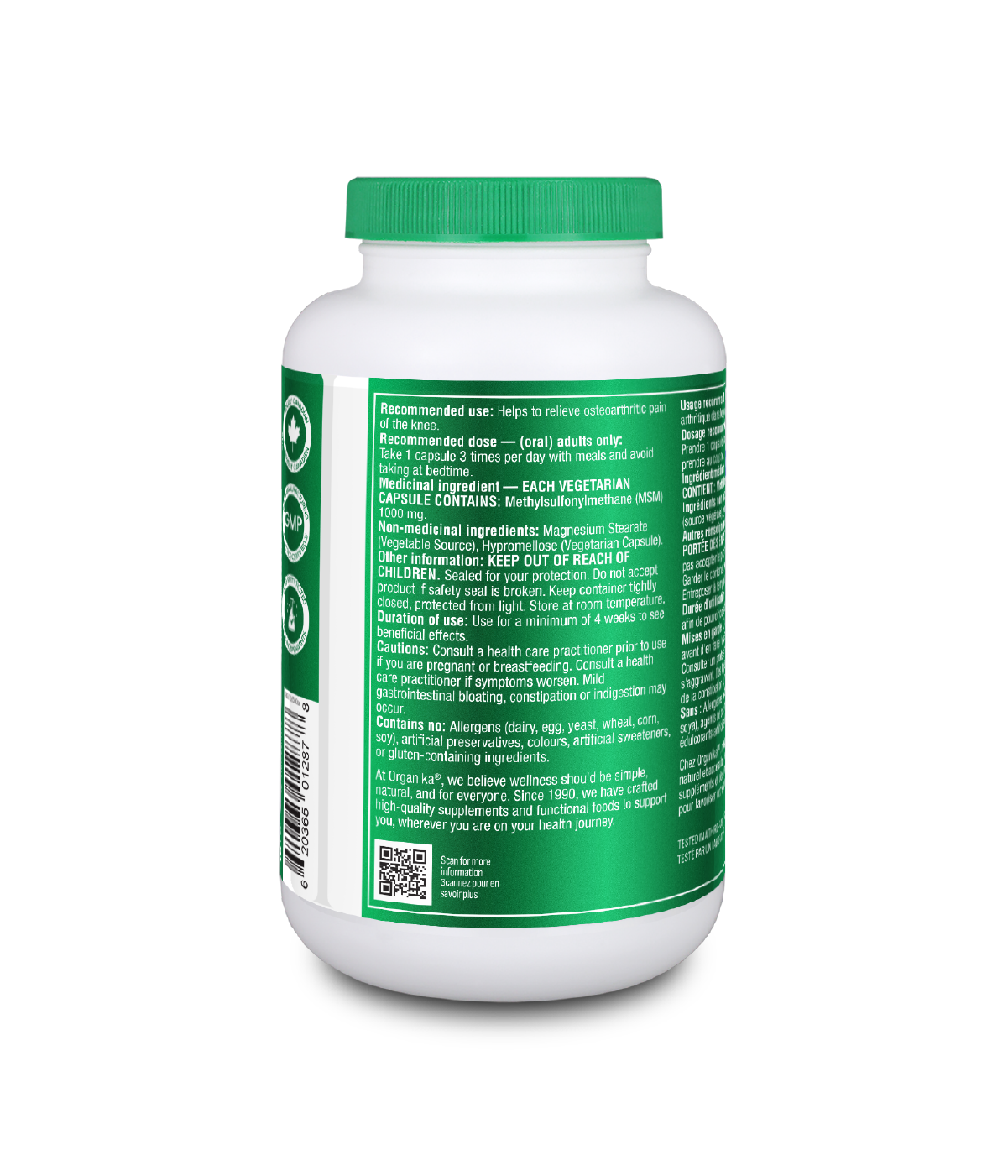
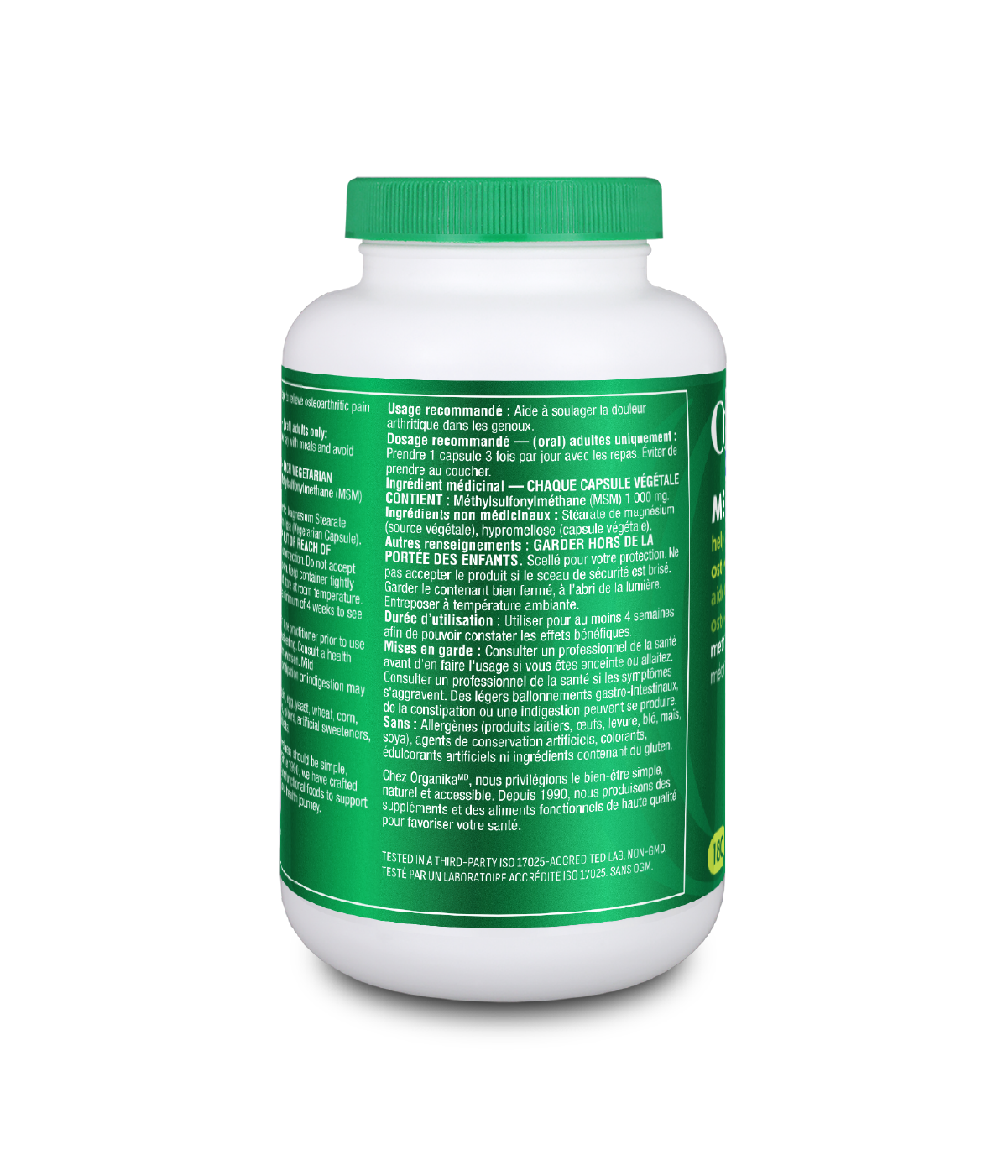
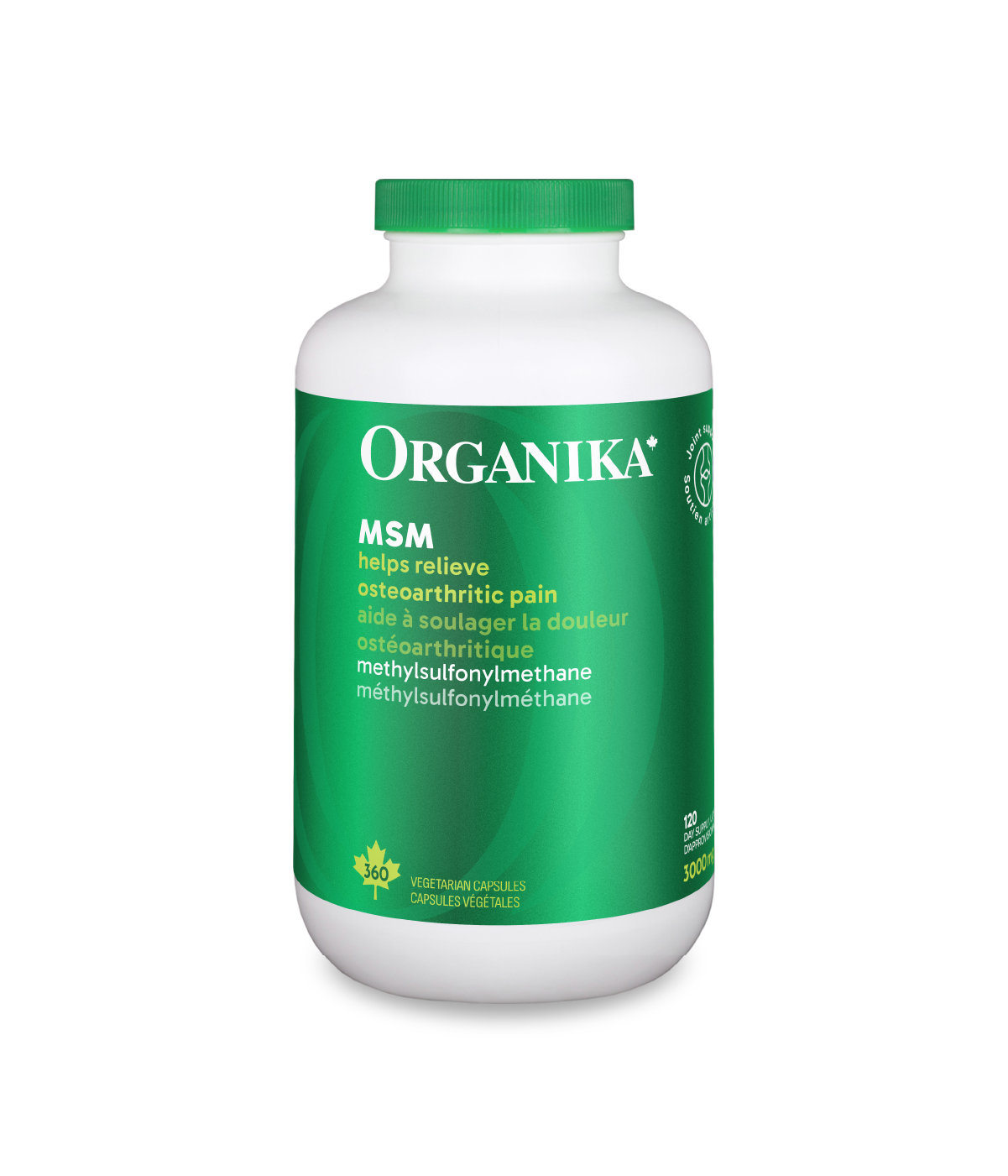
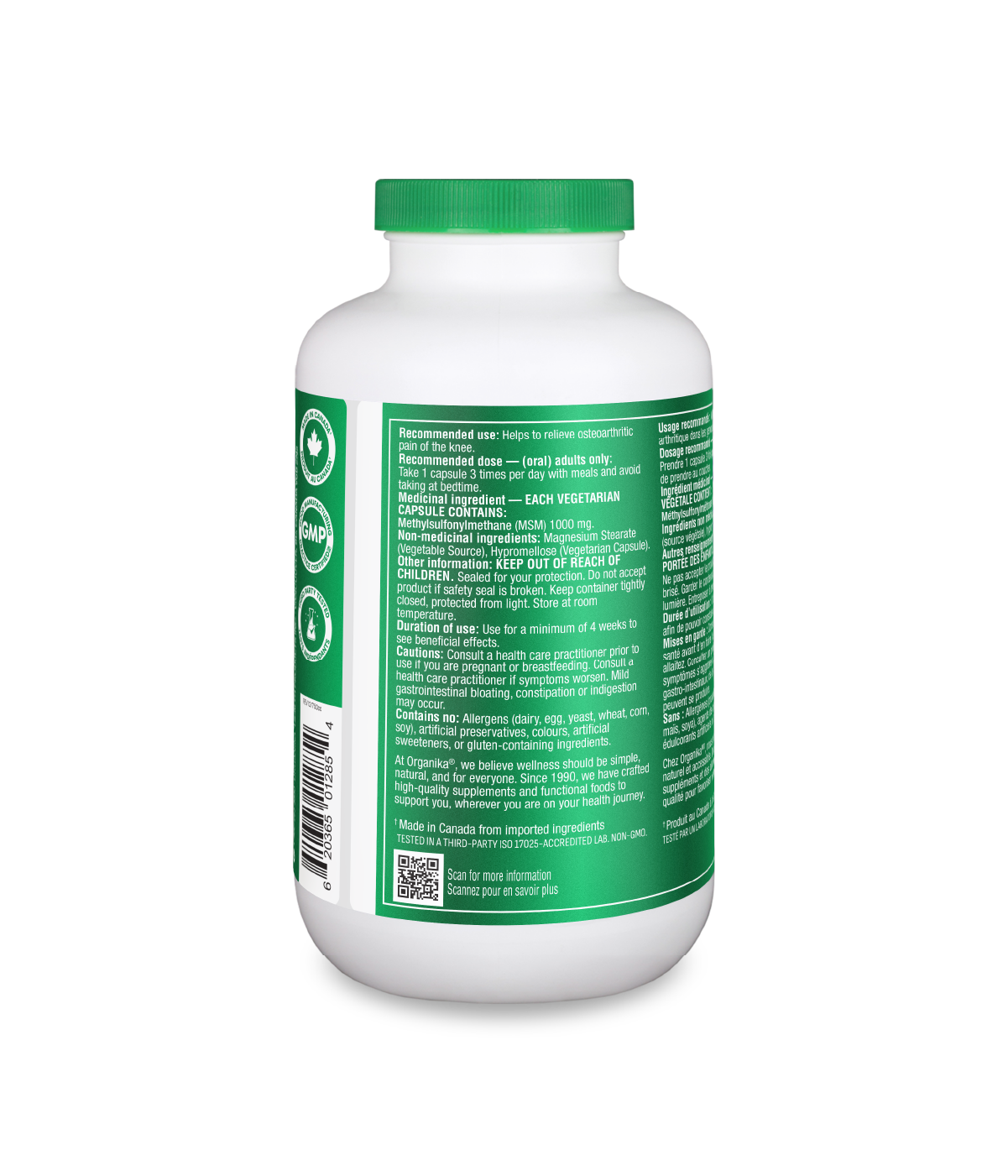
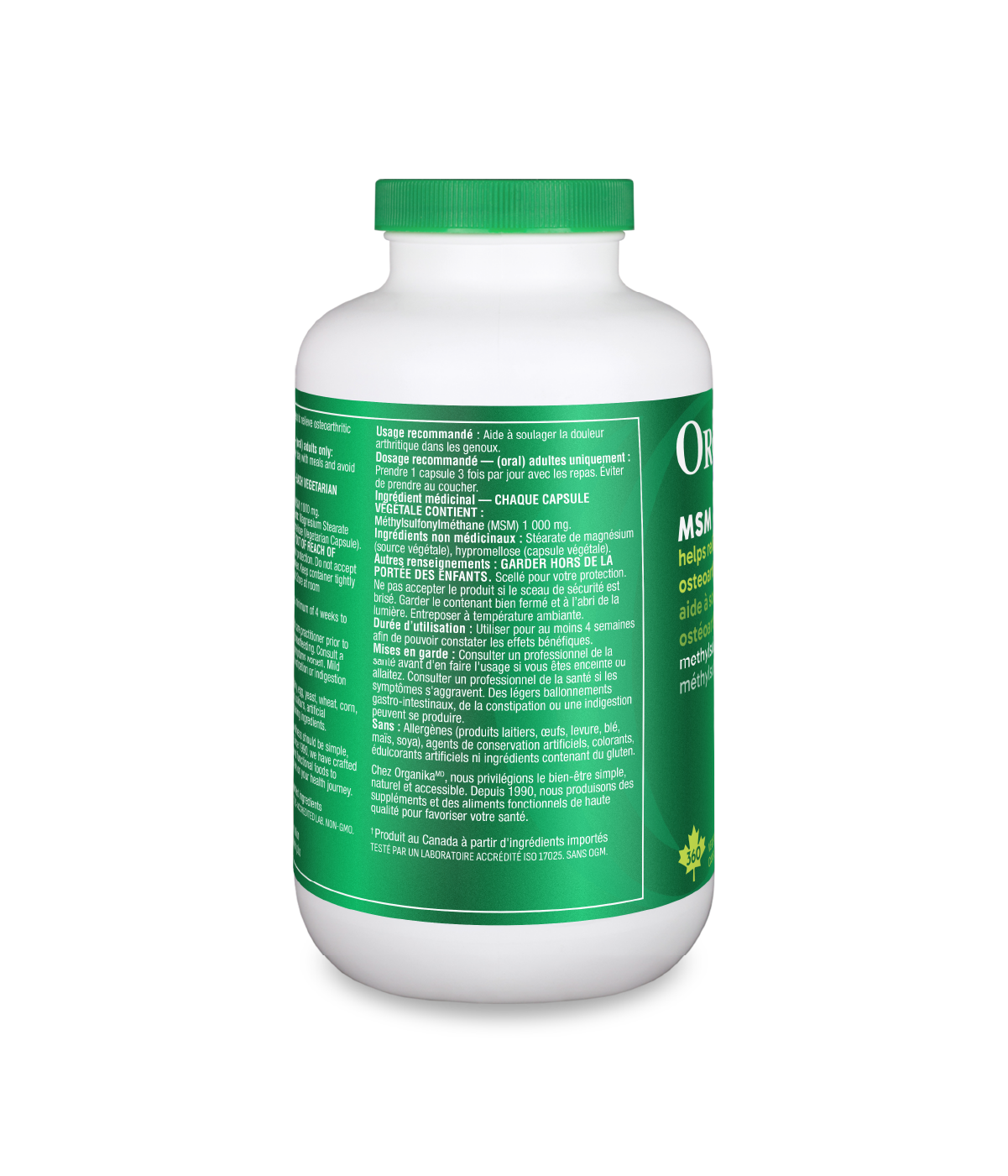
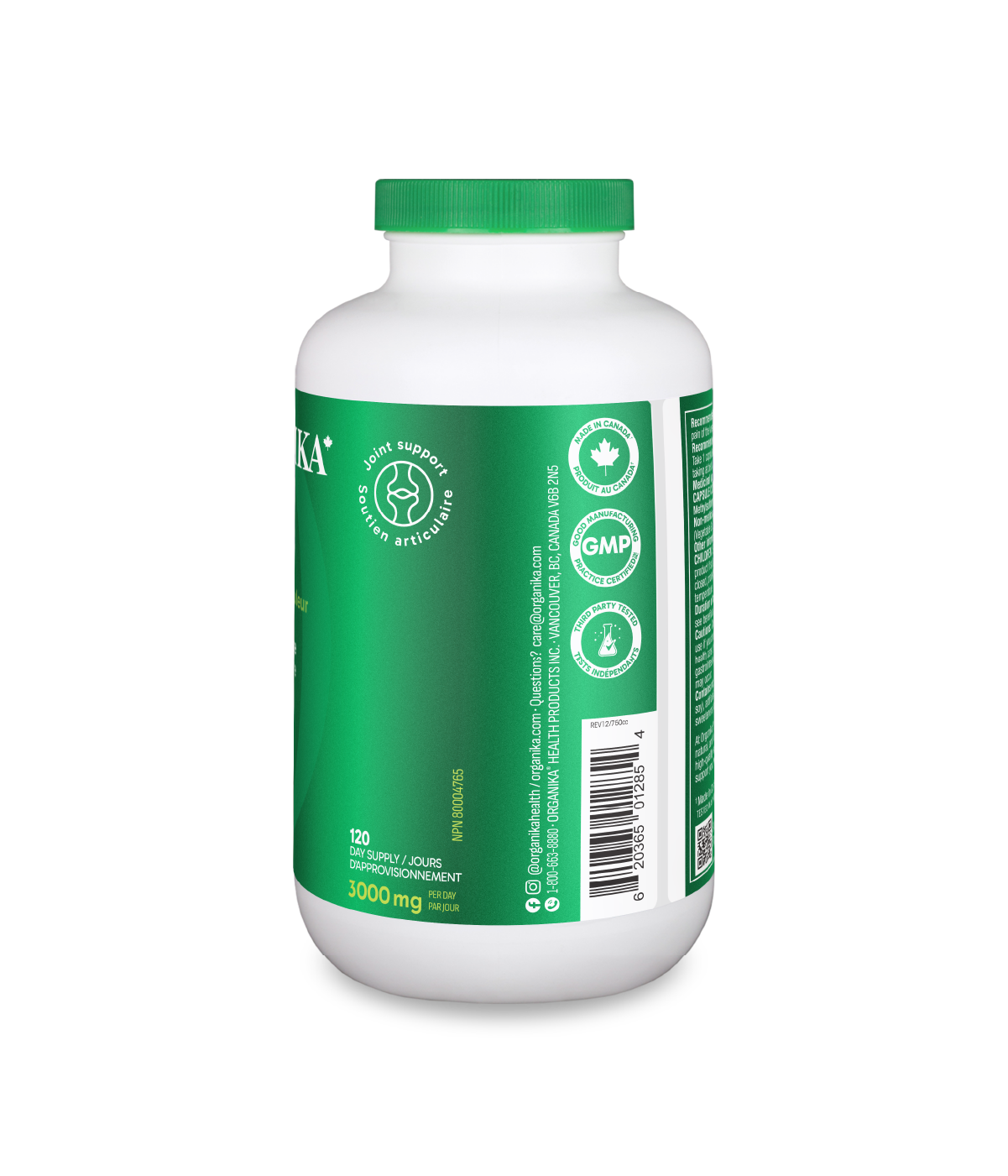















Supplement Facts















Ingredients & Nutrition
MSM 1,000 mg Capsules MEDICINAL INGREDIENT - EACH VEGETARIAN CAPSULE CONTAINS: Methylsulfonylmethane (MSM) 1,000 mg. NON-MEDICINAL INGREDIENTS: Magnesium Stearate (Non-GMO Vegetable Source), Hypromellose / Pullulan (Vegetarian Capsule). MSM Powder
MEDICINAL INGREDIENT - EACH Ω TEASPOON CONTAINS: Methylsulfonylmethane (MSM) 1750 mg. How to Use: 1,000 mg
MSM Capsules RECOMMENDED DOSE - (ORAL) ADULTS ONLY: Take 1 capsule 3 times per day with meals and avoid taking at bedtime.
MSM Powder RECOMMENDED DOSE - (ORAL) ADULTS ONLY: Take 1/2 teaspoon (1750 mg) 3 times per day with meals. Avoid taking at bedtime.
Duration of Use: Use for a minimum of 4 weeks to see beneficial effects.
Cautions: Consult a health care practitioner prior to use if you are pregnant or breastfeeding. Consult a health care practitioner if symptoms worsen. Mild gastrointestinal bloating, constipation or indigestion may occur.
Is This Right for You?
Feeling stiff or sore after activity?
Need support for joint comfort and flexibility?
Looking for a natural way to reduce inflammation?
If you answered "Yes" to any of the above, this product is right for you.

-
Restores flexibility and range of motion
-
Reduces muscle pain and spasms
Ingredients & Nutrition
Recommend For
Feeling stiff or sore after activity?
Need support for joint comfort and flexibility?
Looking for a natural way to reduce inflammation?
If you answered "Yes" to any of the above, this product is right for you.
Gluten-Free
Non-GMO
Vegan Friendly
This sulphur-rich essential supports joint health while reducing inflammation. It helps your body recover, repair and move with ease


The Full Scoop

-
Restores flexibility and range of motion
-
Reduces muscle pain and spasms
MSM is a naturally occurring sulphur compound that does more than just support your joints. Known for its anti-inflammatory properties, MSM helps relieve joint pain, restore range of motion and decrease muscle soreness and spasms, especially in those with osteoarthritis or leading active lifestyles. But it doesn't stop there. MSM supports your body's own antioxidant systems, helping reduce oxidative stress that can lead to premature aging. It also plays a key role in collagen production, which means itís not only good for how you feel, but how your skin, hair and connective tissues function too.
Ask Away
We’ve got the FAQs covered. But if you’re still stuck, we’re only a message away.
Get in TouchI see MSM combined often with glucosamine and chondroitin. Is this necessary?
Some studies have shown that combining these three ingredients together increases their efficacy and reduces time to see the benefits. Youíll find these types of combinations in Organikaís Liga-Joint Premium. This product, by providing MSM alone, allows you to control and increase your personal dose as required, without having to consider the increased doses of other ingredients.
Are there other nutrients that are best to take with MSM?
Taking a supplement of 100 mcg per day or more of molybdenum helps MSM work more effectively. Also, taking a high-quality multivitamin and a potent antioxidant formula is also recommended to maximize the benefits of MSM.
Sulfur sounds important. Can I also get it in my diet?
Absolutely. Many excellent whole foods, like the allium family (garlic, onions, leeks etc.), the cruciferous family (broccoli, cauliflower, Brussels sprouts, kale, etc.), nuts, seeds, dairy products and eggs contain sulfur for the bodyís daily uses.
How does MSM relieve inflammation?
MSM increases the effectiveness of the bodyís natural anti-inflammatory hormone, cortisol. It binds to fluid in swollen tissue and aids in its removal.
You'll Likely Also Love...
Royal Jelly
A rare nutrivite tonic rich in amino acids.
Activated Charcoal Capsules
Gentle digestive relief, the homeopathic way
Curcumin
Relieve aches and pains with turmericís most active compounds
L-theanine Capsules
Feel relaxed and calm while maintaining focus
Support Beyond Products
How to exercise using joint protection techniques Suffering from joint pain can leave you questioning your ability to exercise and stay physically fit. That’s why making sure to exercise with joint protection techniques in mind is so important. Your joints need strong muscles to help support them. Moving your body increases the flexibility of your joints and reduces the stiffness. If you suffer from joint pain, moving the right way for your body can help to improve your performance and overall health. 1. Choose low impact activities Choosing the right types of aerobic exercise, strength training and range of motion movements can go a long way when trying to accommodate joint pain. Low impact exercises are activities that are easier on the body, reduce the risk of injury and provide less stress to your joints. Swimming, cycling, yoga, and walking are some examples of low impact movements that can be more accommodating to joint pain and arthritis. 2. Cross train Mixing up your routine with a few different forms of exercise is great for your body. Cross training helps your body to train different muscle groups through different movements, increasing your strength and performance overall. Cross training is also a great way to stay engaged in being active, preventing you from become bored. 3. Take rest days Giving your joints and muscles a rest can help them to repair and strengthen. Overworking your body increases the risk of injury. Schedule rest days in your weekly routine to give your body time to recuperate. 4. Warm up Doing a gentle warm up session such as going for a walk can help to warm your muscles and prepare them for exercise. Warm muscles are more flexible which helps to reduce the measure of strain they go through during a workout. 5. Don’t overdo it If you’re feeling pain, or find you have long periods of pain after a workout, you’re likely overdoing it. Some mild pain may be normal if you’re not used to working out, but the pain shouldn’t be debilitating. Keep your level of exertion relative to your level of fitness. 6. Drink lots of water Hydration is important for overall health, and that includes your joints. Make sure you drink plenty of water when exercising. The more you sweat the more you need to replenish your body with fluids. 7. Wear the right attire Wearing the right kind of fitness attire for the sport you’re practicing, encourages proper range of motion for healthy joint movement. Don’t restrict your movements from clothing too tight or stiff to move with your body. 8. Cool down Take a period of time to slow your exertion near the end of your routine to allow your body to cool down. Always follow your exercises up with light stretching to help reduce feelings of stiffness the next morning. Most importantly, always remember to listen to your body. If you’re in a lot of pain, or are going through an injury, certain exercises might be more harmful than healthy. Always talk to your doctor before starting a new exercise routine, and consider consulting a physical therapist if you’re dealing with severe joint pain. What kind of exercise do you do?
read moreDon’t let gout pain keep you down, exercise is good for your joints Making exercise a part of your routine might sound crazy if you deal with gout pain. And while exercise isn’t recommended during an acute gout attack, making time for movement in your average weekly routine is definitely still important. Gout is a type of arthritis that causes inflammation in the joints, with acute attacks of sharp paining and swelling. Like other types of arthritis (osteo- or rheumatoid), gout contributes to the deterioration of joint tissue that can disrupt your life. But, letting your joint pain prevent you from exercising can actually be counterproductive overtime. Your joints need strong muscles to help support them. Making time to move your body also increases the flexibility of your joints, and reduces the stiffness. Exercise can also improve your quality of sleep, energy levels and support bone health. It even helps with weight management, which can help to reduce the risk of gout flare-ups. Whether you’re a fairly active person already or more sedentary type, exercising with arthritis is all about finding the right low-impact activities at the right intensities for your body. The 3 Types of Exercise You Want to Include There are different types of exercise that provide different benefits to your health. The perfect balance is including a bit of each type in your routine. 1. Range of Motion Exercise Range of motion exercises include stretching and flexibility movements that help to maintain your joints full range of function. They’re simple exercises that can safely be done on a daily basis. They help to prevent stiffness and improve flexibility and strength within the joint. Simple movements include rolling your shoulders back or moving your head from front to back to side to side. 2. Aerobic Exercise Aerobic exercise, otherwise referred to as cardio exercise, is what gets your heart rate up and improves stamina and energy. It’s great for cardiovascular health, and even stress reduction. You might first and foremost think running when you think about cardio, but there are many other activities that count as aerobic exercise as well. Running can actually be quite high-impact on knee joints, so if you deal with arthritic pain in your knees try opting for something more low impact. Walking, biking and swimming are all examples of low-impact ways to get your aerobic exercise in. 3. Strength Training Strength training is a form of exercise that uses resistance to improve strength and muscle. Muscular strength can help to support the integrity of the joint. The stronger the muscles surrounding the joints are, the less shock the cartilage of the joint is exposed to. Strength training exercises can be done using the machines at a gym, or performed simply in the comfort of your home by purchasing a couple of weights or resistance bands. Strength training can also include body weight exercises such as push-ups or planks, that use the weight of your own body as the resistance factor. Having proper form when strength training is key in order to get the most from your exercise, while also preventing injury. If you’ve never done any weight baring exercise before, taking a couple of personal training sessions can help you to learn proper form and exercises suitable for your condition. Once you start exercising, make sure you leave time for your body to recover between workouts. Avoid exercising the same muscle groups day after day in a row, and start slow. If you’re feeling a lot of pain during or after exercising, you’re likely overdoing it. Staying active is an important part of managing the pain that comes with gout and other types of arthritis. One of the best things you can do when it comes to incorporating exercise into your weekly routine is finding something that you truly love to do. Go for walks with a friend, try a yoga class or head out on a hike. Remember, exercise doesn’t need to be intense. Even day to day activities like mowing the lawn or taking the stairs count towards keeping your joints active. Remember to talk to your healthcare practitioner before starting a exercise routine. Your doctor can help suggest exercises for your condition, plus tell you how much intensity is safe for your current state of fitness! What's your favourite type of exercise References: http://goutandyou.com/gout-and-exercise/ http://www.arthritis.org/living-with-arthritis/exercise/benefits/exercise-knee-osteoarthritis.php http://www.mayoclinic.org/arthritis/art-20047971?pg=1 https://consumer.healthday.com/encyclopedia/arthritis-3/demographic-arthritis-news-37/weightlifting-and-arthritis-645281.html
read moreYou’ve probably heard about the benefits of medium chain triglycerides (MCTs) already. You might even be adding it to your morning coffee or throwing it in your dressings. Most likely, it’s because you’ve heard that they can boost energy, improve brain function and maybe even help you lose weight… and they can! But the benefits of MCTs don’t stop there. I recommend getting MCTs in your diet if you have impaired digestion, inflammation or leaky gut. MCTs can improve all of these conditions through various mechanisms that help to heal your gut, calm your immune system and reduce inflammation. In my practice, these are our primary goals when we’re looking to combat autoimmune disease and many other chronic illnesses. Reduce Pro-Inflammatory Cytokines MCTs can dramatically reduce the production of a variety of proinflammatory cytokines (1). Cytokines are small secreted proteins released by cells that have a specific effect on the interactions and communications between cells (2). Proinflammatory cytokines are secreted by immune cells like helper T cells (Th-1 and Th2), which are out of balance in those with autoimmune disease (3). These types of cytokines promote inflammation and, when excreted in excess, contribute to systemic damage, autoimmune attacks and inflammatory diseases. The proliferation of these types of cytokines has also been linked to depression and other neurological diseases (4). Medium chain triglycerides seem to have the ability to reduce the production of these pro-inflammatory molecules. In the gut and throughout the rest of the body (5), they an be used as a powerful tool for reducing inflammation in those afflicted with these inflammatory symptoms. They can also work as a preventative measure for regulating the immune system (6). Reduce Histamine MCTs can increase the activity of the histamine-clearing enzyme diamine oxidase (7). This prevents the ability for histamine to build up in your system, which can cause histamine intolerance or allergy. Histamine is an inflammatory compound released by mast cells and basophils, which are most prevalent at sites of potential injury – the nose, mouth, feet, gut and blood vessels (8). Histamine is released when these mast cells or basophils are exposed to allergens. This is when you get your itchy eyes, runny nose, sneezing and other common allergic responses. It may also result in headaches or migraines, fatigue, hives, digestive issues, nausea, vomiting, abdominal cramping, heart palpitations, tissue swelling and high blood pressure. These are the symptoms of histamine intolerance. A histamine intolerance is usually developed due to an overproduction of histamine or an inability to clear histamine. This is due to a deficiency in the enzyme diamine oxidase (DAO), which clears it (9). You show symptoms when the amount of histamine hits a tipping point, like a glass of water overflowing. To get that histamine intolerance under control, we must reduce histamine production, increase DAO and often reduce histamine consumption (it’s in our food too!). Reducing histamine can be an important part of calming autoimmune disease because the inflammatory molecules have the ability to localize in place where your autoimmune disease is already causing damage, intensifying the inflammatory response in those areas (10). MCTs are just one valuable tool we can implement to help support the activity of DAO to reduce the proliferation of histamine and calm the autoimmune response. Increase Mucous Production The mucous layer is a protective coating that covers the entire GI tract. Without it, our gut is vulnerable to ulcers, infection, inflammation and, of course, leaky gut (11). Our mucosal layer is often damaged due to stress, bacterial overgrowth, excess sugar consumption, overuse of NSAIDs, and consumption of food allergens (12, 13). MCTs can increase mucous production in the gut to restore your gut barrier health (7). This is essential for the prevention and reduction of autoimmune attacks, as it may help to prevent infections and reduce inflammation in the gut as well as improve overall digestion, absorption and assimilation of nutrients (14, 15). Heal Leaky Gut A “leaky gut” is the colloquial way of saying increased intestinal permeability. This is, essentially,a condition in which your gut barrier is faulty. It allows undigested food, bacteria and other substances from the GI tract, through to the bloodstream. When this happens, we expose our immune system to stimuli that can mount intense immune responses and create antibodies. As this persists, those antibodies may become confused and attack your bodies own tissues and organ systems – this is the mechanism of autoimmune disease (16). For this reason, healing a leaky gut is the first step in healing autoimmune disease. MCTs may help to do this in two ways. MCTs can help to restore tight junction proteins (17). Your tight junction proteins are the little guys that hold the cells of your gut lining together. If they are damaged or malfunctioning, a leaky gut occurs. If we can restore tight junction proteins, we are on our way to healing leaky gut. MCTs can help to increase cell-turnover rate in the gut (18). Sometimes, when we see increased intestinal permeability, the tight junctions are not the problem. Rather, there has been damage to the cells of the gut lining that has created holes or pathways through them. If we can increase the cell-turnover rate, we can replace those damaged cells more rapidly. Through both of these mechanisms, MCTs can be a valuable addition to your diet for healing and preventing leaky gut. Increase Secretory IgA Secretory IgA (sIgA) is an antibody secreted by mucosal tissue and acts as the first line of defense of the GI mucosa and epithelial cells of the gut lining. It may also play an important role in the regulation of microbiota composition and in decreasing proinflammatory responses from pathogenic bacteria and allergenic antigens. Low sIgA is highly associated with increased autoimmune disease risk. MCTs can can naturally increase the secretion of IgA antibodies in the gut, especially in Peyer’s Patches an important part of your GI immune system (19). So how should I include MCTs in my diet? If you have never used MCTs in your diet before, I recommend that you start with MCT oil powder. MCT oil is known to cause digestive upset in beginners. This is likely due to the way we metabolize it very quickly. This can cause a physiological response that promotes movement and sometimes cramping. It may also be due to the ability of lauric acid to eliminate bacteria and yeast. When we kill them off we often experience irritation in the gut and sometimes peripheral symptoms such as redness or headaches. Both of these reactions tend to pass over time. By slowly increasing the amount you take, your body can adjust. To bypass these nasty side effects altogether, I recommend the MCT oil powder, which is proven to be easier on the digestive system. This allows you to consume more at once. A preliminary study also suggests that MCTs in the form of powder could improve nutrient digestibility. As well, MCT oil powder tends to be more convenient. You can pack it into smaller containers and take it wherever you need to go without worrying about spilling or leaking. It is also much lighter for travel, and is a more versatile product. Where the oil can be added to a hot drink or dressing, the powder can be added to virtually any dish. It works especially great in baking! I recommend starting with my MCT Collagen Macaroons! Find an AIP coach near you on this database or contact me, Megan O’Kelly (CNP), The Realistic Holistic, at info@therealisticholistic.com to see if I am the right nutritionist to help you through your autoimmune journey! Follow along my journey in Instagram! SOURCES 1) Zhong, W, et al. “Dietary Fat Sources Differentially Modulate Intestinal Barrier and Hepatic Inflammation in Alcohol-Induced Liver Injury in Rats.” PubMed, U.S. National Library of Medicine, 10 Oct. 2013, www.ncbi.nlm.nih.gov/pubmed/?term=Dietary fat sources differentially modulate intestinal barrier and hepatic inflammation in alcoholinducedliver injury in rats. 2) Zhang, Jun-Ming and Jianxiong An. “Cytokines, inflammation, and pain” International anesthesiology clinics vol. 45,2 (2007): 27-37 3) Kim, BS., Park, YJ. & Chung, Y. Arch. Pharm. Res. (2016) 39: 1537. https://doi.org/10.1007/s12272-016-0823-8 4) Young, Juan Joseph, et al. “A Review of the Relationship between Proinflammatory Cytokines and Major Depressive Disorder.” NeuroImage, Academic Press, 30 July 2014, https://pubmed.ncbi.nlm.nih.gov/25128861/. 5) Akira Andoh, Hiroki Takaya, Yoshio Araki, Tomoyuki Tsujikawa, Yoshihide Fujiyama, Tadao Bamba; Medium- and Long-Chain Fatty Acids Differentially Modulate Interleukin-8 Secretion in Human Fetal Intestinal Epithelial Cells, The Journal of Nutrition, Volume 130, Issue 11, 1 November 2000, Pages 2636–2640, https://doi.org/10.1093/jn/130.11.2636 6) Mantis, N J et al. “Secretory IgA's complex roles in immunity and mucosal homeostasis in the gut” Mucosal immunology vol. 4,6 (2011): 603-11. 7) Ishii, K., Kono, H., Hosomura, N. et al. J Gastroenterol (2009) 44: 204. https://link.springer.com/article/10.1007%2Fs00535-008-2308-0. 8) Kovacova-Hanuskova, E, et al. “Histamine, Histamine Intoxication and Intolerance .” Comenius University in Bratislava, Jessenius Faculty of Medicine, Department of Pathophysiology, Mala Hora, 036 01 Martin, Slovakia, Elsevier, 1 May 2015, www.elsevier.es/en-revista-allergologia-et-immunopathologia-105-linkresolverhistamine-histamine-intoxication-intolerance-S0301054615000932 9) Laura Maintz, Natalija Novak; Histamine and histamine intolerance, The American Journal of Clinical Nutrition, Volume 85, Issue 5, 1 May 2007, Pages 1185–1196, https://doi.org/10.1093/ajcn/85.5.1185 10) Kim, Kyoung-Woon, et al. “Histamine and Histamine H4 Receptor Promotes Osteoclastogenesis in Rheumatoid Arthritis.” Nature News, Nature Publishing Group, 26 Apr. 2017, https://www.nature.com/articles/s41598-017-01101-y. 11) Pelaseyed, Thaher et al. “The mucus and mucins of the goblet cells and enterocytes provide the first defense line of the gastrointestinal tract and interact with the immune system” Immunological reviews vol. 260,1 (2014): 8-20. 12) Faderl, Martin, et al. “Keeping Bugs in Check: The Mucus Layer as a Critical Component in Maintaining Intestinal Homeostasis.” Biochemistry and Molecular Biology Education, Wiley-Blackwell, 24 Apr. 2015, https://pubmed.ncbi.nlm.nih.gov/25914114/. 13) Luissint, Anny-Claude et al. “Inflammation and the Intestinal Barrier: Leukocyte-Epithelial Cell Interactions, Cell Junction Remodeling, and Mucosal Repair” Gastroenterology vol. 151,4 (2016): 616-32. 14) Hansson, Gunnar C. “Role of mucus layers in gut infection and inflammation” Current opinion in microbiology vol. 15,1 (2011): 57-62. 15) Hong, S M et al. “Effect of Medium-chain Triglyceride (MCT) on Growth Performance, Nutrient Digestibility, Blood Characteristics in Weanling Pigs” Asian-Australasian journal of animal sciences vol. 25,7 (2012): 1003-8. 16) Bischoff, Stephan C et al. “Intestinal permeability--a new target for disease prevention and therapy” BMC gastroenterology vol. 14 189. 18 Nov. 2014, doi:10.1186/s12876-014-0189-7 17) Yan, Hui and Kolapo M Ajuwon. “Butyrate modifies intestinal barrier function in IPEC-J2 cells through a selective upregulation of tight junction proteins and activation of the Akt signaling pathway” PloS one vol. 12,6 e0179586. 27 Jun. 2017, doi:10.1371/journal.pone.0179586 18) Derek J. Ruthig, Kelly A. Meckling-Gill; Both (n-3) and (n-6) Fatty Acids Stimulate Wound Healing in the Rat Intestinal Epithelial Cell Line, IEC-6, The Journal of Nutrition, Volume 129, Issue 10, 1 October 1999, Pages 1791–1798, https://doi.org/10.1093/jn/129.10.1791 19) Faderl, Martin, et al. “Keeping Bugs in Check: The Mucus Layer as a Critical Component in Maintaining Intestinal Homeostasis.” Biochemistry and Molecular Biology Education, Wiley-Blackwell, 24 Apr. 2015, https://pubmed.ncbi.nlm.nih.gov/25914114/.
read more





